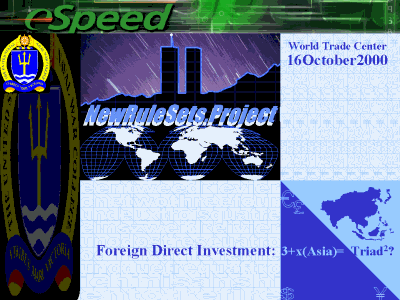
Foreign Direct Investment:
Decision Event Report II of the
NewRuleSets.Project
by
Dr. Thomas P.M. Barnett
with
Prof. Bradd C. Hayes
and inputs from
Dr. Lawrence Modisett
Cdr. Carl Carlson, USN
Prof. Gregory Hoffman
18 May 2001 final draft
Contents
I. Project overview and introduction
II. The Asian Energy Futures key findings
III. The Foreign Direct Investment workshop
IV. Starting line analysis
V. The Here and Now of FDI in Asia
VI. The New Rule Sets of FDI in Asia
VII. The There and Then of FDI in Asia (2010)
VIII. Cosmic conclusions about the future(s) of FDI in Asia
I: Project overview and introduction
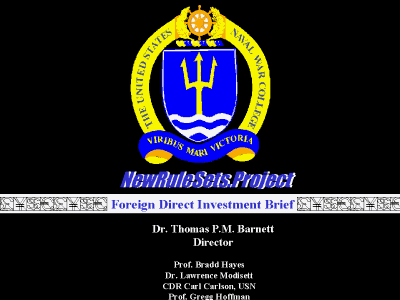
This annotated briefing serves as the Decision Strategies Department (DSD) Report for the Foreign Direct Investment: 3+x(Asia)=Triad2? decision event held in New York City on 16 October 2000.
As of 25 May 2001, this summary brief of the NewRuleSets.Project (both an overview of the project and a summation of the Asian Energy Futures and Foreign Direct Investment events) has been presented on approximately 50 occasions to a variety of Washington think tanks, government agencies, and Wall Street firms. Future briefs are always being scheduled, so contact Tom Barnett directly if you are interested in receiving the brief.
The original draft of the Foreign Direct Investment report was posted on the Naval War College’s web site ) on 9 April 2001. Comments on this final version are welcome from all quarters, but especially from the workshop’s participants and anyone who’s seen the brief in person. Comments should be emailed directly to Tom Barnett, the project’s director (<barnettt@nwc.navy.mil>). He can also be reached by phone at 401.841.4053.
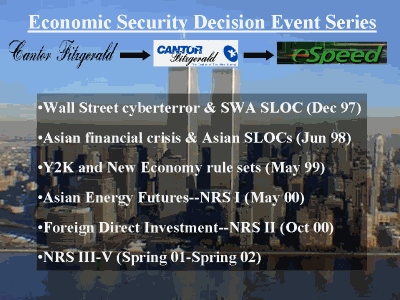
The Foreign Direct Investment event was the fifth in a series of Economic Security Exercises that the DSD has conducted in New York City with the support of Cantor Fitzgerald, the world's largest broker of U.S. Government securities, Eurobonds, and sovereign debt. These events are designed to bring together the worlds of finance and national security to explore issue areas of common interest and, by doing so, build mutual understanding.
For more than 25 years, Cantor Fitzgerald has played a pioneering role as a private-sector intermediary for the fixed income markets. In the early 1970s, Cantor developed the world's first screen-based marketplace for the trading of U.S. government securities. In 1998 it created Cantor Exchange, the first U.S. electronic futures exchange for U.S. Treasury futures. In 1999, Cantor launched a new division known as eSpeed to operate all of its electronic markets. All told, Cantor’s business operations involve financial flows of approximately 50 to 70 trillion dollars a year.
Cantor Fitzgerald provided significant analytic and organizational support to the first three Economic Security Exercises in the series:
- December 1997 event focused on a dual cyber terrorism/disruption of the sea lines of communication (SLOC) scenario involving Wall Street and Southwest Asia, respectively (hard copy of event report is available from the DSD by calling 401-841-1798)
- June 1998 event focused on a dual financial crisis/SLOC disruption in Asia involving Indonesia (hard copy of event report is available from the DSD by calling 401-841-1798)
- May 1999 event focused on the potential global financial repercussions of a substantial Year 2000 Problem (find the report online at ).
eSpeed has stepped to the fore on the NewRuleSets.Project, and serves as Cantor’s support lead for all five of the planned Economic Security Exercises envisioned in this project, beginning with the inaugural Asian Energy Futures event of May 2000 (find the report at <www.nwc.navy.mil/newrulesets/AEFreport.htm>).
The NewRuleSets.Project is a two-and-a-half-year, five-workshop effort designed to explore how globalization and the rise of the New Economy are altering the basic "rules of the road" in the international security environment, with special reference to how these changes may redefine the U.S. Navy's historic role as "security enabler" of America's commercial network ties with the world. Not a data gathering effort, this project lives and dies with the participants we bring together at our workshops—from throughout the global financial and national security communities. The project has five main goals:
- Explore how globalization and the rise of the New Economy are generating new rule sets with regard to how nation-states and national economies interact with one another
- Determine how these new rule sets alter the basic "rules of the road" in the international security environment
- Link these changes in the international security environment to the U.S. Navy's current quest for a "transformation strategy," with special reference to how these changes may redefine the U.S. Navy's historic role as "security enabler" of America's commercial network ties with the world
- Translate these changes in the international security environment into conceptual paradigms of use to strategic planners in the international financial community
- Generally deepen the cross-cultural understanding both sides—the Pentagon and Wall Street—bring to the table during periods of overlapping geo-strategic and geo-economic instability.
Dr. Thomas P.M. Barnett serves as project director. He is currently a Professor/Senior Strategic Researcher in the DSD. Other DSD personnel involved in the project include:
- Prof. Bradd Hayes, Senior Strategic Researcher, DSD
- Dr. Lawrence Modisett, Chairman, DSD
- CDR. Carl Carlson, USN, Deputy Chairman, DSD
- Prof. Gregory Hoffman, Associate Researcher, DSD.
The global rule set that has characterized international relations throughout the Cold War period finds its roots in the systemic stresses of the 1930s—namely, the Great Depression and the rise of fascism in Europe. These twin developments led inexorably to the Second World War, from which sprang the hope that "never again" would the international community allow itself to engage in the sort of economic protectionism that destroyed most of the global economic connectivity achieved by “Globalization I” (roughly, 1870 to 1929).
Based on that "never again" spirit, the postwar Western great powers, led by the United States, attempted to "firewall off" the experiences of the 1930s by creating a new global rule set, whose main attributes were exemplified by such international organizations as the General Agreement on Trade and Tariffs, the UN, the International Monetary Fund (IMF) and the World Bank (WB).
This new global rule set engendered the second great period of economic globalization, creating what we've come to know as the globally networked "New Economy." As this New Economy spreads across the planet, it has suffered significant "growing pains" (e.g., Mexico ’94, Asia ’97-’98, Russia ’98, Brazil ’98-’99), leading some to question whether the postwar rule set is still appropriate for the 21st Century. In other words, as national economies become increasingly intertwined in this information technology-driven New Economy, legitimate questions arise as to whether or not a new global financial architecture is in order and, if so, what it might entail.
While not focusing specifically on any of the ideas currently forwarded by economists for such a new financial rule set, our project takes as its starting premise that the current era will witness great change in the planet’s economy, and that these changes will eventually alter our definitions of national security.
NOTE: A portion of this text is adapted from Thomas P.M. Barnett et. al, Final Report of the Year 2000 International Security Dimension Project, DSD Report 00-5, pp. 15-16, found online at .
As our starting point for analyzing how an emerging new global economic rule set could alter U.S. definitions of national security, we employ the three-tiered analytic perspective introduced by Kenneth Waltz in his seminal 1954 book on the theory of the causality of war entitled, Man, the State and War (New York: Columbia University Press). Waltz’s approach to this eternal question (“Why do interstate wars start?”) was simply to “view” the matter from three separate perspectives, which he labeled “images”:
- The first image, or “bottom up” perspective, is that of humanity itself, or better stated, human nature. In other words, the question he posed was, is it the essential nature of humanity to engage in violence?”
- The second image, or “straight on” perspective, involves the nation-states themselves. In other words, do certain types of states instigate wars while others do not?
- The third image, or “top down” perspective, involves the all-encompassing international system within which these wars between states occur. In other words, does the current structure (i.e., lacking Thomas Hobbes’ Leviathan, or authoritative enforcer of global order) simply allow or even encourage conflict among states?
In essence, Waltz used these three perspectives to test—or poke holes in—conventional wisdom concerning the presumed complicity of man, states and the international system in fomenting war.
We likewise employ Waltz’s analytical framework in discerning the future of inter-state relations in the post-Cold War era, which we will label the Era of Globalization. We think this three-tiered approach forces a certain discipline to our analysis by pushing us to dis-aggregate the emerging global rule sets according to the “location” of the needs they seek to address—namely, the international system, state governments, or individuals.
NOTE: A portion of this text is adapted from Thomas P.M. Barnett et. al, The U.S. Marine Corps and Non-Lethal Weapons in the 21st Century: Annex A—Alternative Global and Regional Futures, Center for Naval Analyses Quick-Response Report 98-9, September 1998, pp. 2-3.
It is our baseline contention that most militaries—but especially the U.S. military—are largely “frozen” in Waltz’s nation-state image. Why so?
In the Cold War, things were fairly straightforward, as both the international system (through blocs) and individuals (through ideologies) were kept in strict subordination to the state-centered superpower conflict. So when the Pentagon looked abroad, all it saw was "us" and "them" states, with that pesky nonaligned gang in between. The focus on states remains to this day. We call it the "Willie Sutton effect," after the famous bandit who, when asked why he robbed banks, replied, "Because that's where the money is." In other words, nation-states have long served as the preeminent collection point (i.e., taxes) for collective security efforts (militaries), but that has begun to change.
The United States has not yet adjusted its state-centered defense policy to account for the two biggest security trends of the globalization era:
- Power and competition have shifted upward, from the state to the system (in the form of the global economy, culture, and communications grid).
- Violence and defense spending (e.g., small arms races, private security firms) have shifted downward, from the state to the individual.
- Worldwide state defense spending and arms transfers are down dramatically from Cold War peaks, leaving some observers to wonder if the U.S. military is being disintermediated from the global security environment—namely, the perception that it is both irrelevant to the rising market of system perturbations (e.g., financial crises) and largely impotent in responding to the booming market of civil strife. While this is a decidedly harsh judgment, we think it’s important to consider the possibility that the U.S. military is—in effect—losing its market share as global security is transformed by the New Economy.
NOTE: A portion of this text is adapted from Thomas P.M. Barnett, “Life After DODth or: How the Evernet Changes Everything,” U.S. Naval Institute Proceedings, May 2000, p. 48.
Our take on the future stems from our appreciation of the different trends we see unfolding across the three Waltzian perspectives. First and foremost, we see a future of fewer interstate wars. The early 20th century's high volume of state-on-state warfare will not carry over into the 21st. Nuclear weapons ended great power-versus-great power warfare back in 1945, and as John Keegan predicts, the future belongs far more to civil strife than traditional war.
However, on the international system level we’ll see the U.S. government focusing a lot of diplomatic attention on trying to keep systemic crises—usually triggered by financial tumults—from blossoming into real conflicts among states. Much of this future potential for system-based conflict arises from threats to the global information infrastructure (GII). We get only the slightest hint of this possible future through the emergence of worldwide computer viruses such as the “Love Bug” virus of early 2000. For now, such disruptions seem relatively minor, and since no focused motivations lie behind the acts, little danger is perceived. But it only makes sense that as Information Age economies become increasingly dependent on the movement of raw data, much as Industrial Age economies depended on the movement of raw materials, system-based conflict will be characterized by focused and well-motivated attacks on GII functioning. In short, this is a growing market.
In comparison, real conflicts below the level of the nation-state (i.e., civil strife) should remain fairly constant in the future. Globally there have been a good three to four dozen conflicts every year since World War II that generate 1,000 or more casualties. And while these conflicts are real, U.S. interests tend to be virtual, affording us the flexibility to choose the ones we want to deal with (e.g., Bosnia) and to turn a blind eye to those we don't (e.g., Rwanda).
NOTE: A portion of this text is adapted from Barnett, “Life After DODth,” p. 51.
So where can a military fit in this new global environment, where almost all the important crises are either too global or too local for most states to tackle with military force? In a world featuring both integrating globalization (i.e., we are all drawn together by the Internet, transportation, mass media, e-commerce, etc.) and dis-integrating localization (so why then do so many societies and economies seem to be coming apart at the seams?), the great challenge facing governments is fostering compromises between the two, otherwise known as glocalization—adapting the local to the global in ways that improve the former's living standards.
Naturally, this can be fairly contentious, with many societies resisting what Thomas Friedman calls "revolution from beyond” (see his The Lexus and the Olive Tree; New York, Farrar Straus Giroux, 1999). In many societies, globalization is looked upon as forced Americanization, and frankly, that’s too much for most people to swallow. Localization, then, becomes a largely anti-Western rejection of the social homogenization fueled by globalization. In turn, any rejection of globalization constitutes a rejection of the concept of a single global rule set, meaning you tell the world, “Hey, in this corner of the planet we do things differently!” You can call it “Asian values,” or “Chinese characteristics,” but in effect you’re just saying that local identity still matters, even as your region may increasingly embrace globalization and all the social and political change that it ultimately forces.
In short, glocalization is the containment of the Globalization Era—sort of a dot.communism, love it or leave it. This individual choice, made again and again in societies throughout the world, will define the ideological conflict of this age: Davos Man (globalization) versus Seattle Man (localization).
NOTE: A portion of this text is adapted from Barnett, “Life After DODth,” pp. 49-50.
All of the published analytic output connected with the NewRuleSets.Project is available online at the Naval War College’s web site at the following address: http://www.nwc.navy.mil/newrulesets.
The web site provides a Project Summary, which we will update on a regular basis as the multi-year research effort unfolds.
For each decision event, such as the Foreign Direct Investment event, we will post three products:
- Read-ahead package that details the event from a procedural standpoint
- Copy of the brief slides
- Event report, such as this annotated briefing.
The web site also offers links to various related sites:
- Naval War College
- Center for Naval Warfare Studies
- Decision Strategies Department
- Biographies of NewRuleSets.Project personnel
- eSpeed.
The web site also offers direct email to project director Tom Barnett for the purposes of commentary and feedback.
The Foreign Direct Investment event is the second of at least five Economic Security Exercises we plan on conducting for the NewRuleSets.Project. Our current schedule is as follows:
- Asian Energy Futures (conducted 1 May 2000)
- Foreign Direct Investment (conducted 16 October 2000)
- Special Decision Event with the National Intelligence Council (conducted 6 December 2000 at the Center for Strategic Studies, Alexandria VA)
- Asian Environmental Solutions (planned for 4 June 2001)
- Special Decision Event with the Naval War College Foundation Board of Trustees (planned for 14 June 2001)
- Food and water resources (tentatively Fall 2001)
- Critical assets of the New Economy (tentatively Spring 2002).
Beyond the June 2001 events, the schedule is tentative and subject to change. We may also add additional events as the research warrants.
Each of the decision events—unless otherwise noted—will occur in one of two places:
- Windows on the World conference center, World Trade Center, New York City
- Decision Support Center, McCarty-Little Hall, U.S. Naval War College, Newport, Rhode Island.
If you or someone you know is interested in attending one of these events (space is extremely limited), please feel free to contact project director Tom Barnett with your nominations.
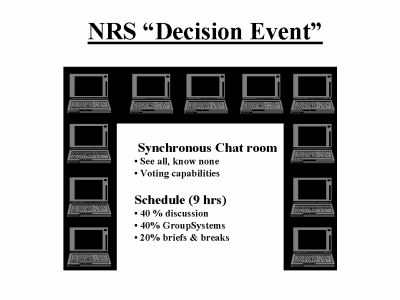
Each of the decision event workshops involve roughly thirty participants drawn equally from the financial community, the political-military community, and the regional expert community. The point of the effort is not to amass the most impressive collection of focused subject-matter experts, but to bring together a diverse array of experts, decision makers, and opinion leaders from both the public and private sectors, and let the synergy of their intellectual interactions serve as the fundamental analytic output. In short, the goal of our workshops is a "clash of paradigms," and not a rigorous forecasting effort.
These decision events typically unfold over four to five major sessions. Each session involves both facilitated discussion by the group as a whole and individual participation in collective brainstorming tasks, in which we employ a decision software system known as GroupSystems. Using GroupSystems, each participant enters ideas anonymously via a dedicated laptop, while simultaneously commenting on each other’s inputted ideas asynchronously via a portable Local Area Network, or LAN. In effect, then, we intersperse facilitated discussion with a LAN equivalent of a "chat room" where we explore numerous specific ideas in greater detail.
II: The Asian Energy Futures key findings

The following five slides summarize the decision event report we published concerning our first workshop in the series, Asian Energy Futures. This report is found online at .
The following individuals participated in this workshop:
- Dr. David Baldwin, Columbia University
- Mr. Jim Bishop, Caithness Energy
- Mr. Jim Caverly, Department of Energy
- VAdm. Arthur Cebrowski, USN, U.S. Naval War College
- Dr. Alberto Coll, Center for Naval Warfare Studies
- Capt. Dave Duffie, USN, Council on Foreign Relations
- Dr. Dennis Eklof, Cambridge Energy Research Associates
- Mr. Mike Feeley, Sino-American Development Corporation
- Adm. William Flanagan, USN (ret.), Cantor Fitzgerald
- Dr. Ellen Frost, Institute for International Economics/National Defense University
- Mr. Doug Gardner, eSpeed
- Dr. Philip Ginsberg, Cantor Fitzgerald
- Dr. David Gordon, National Intelligence Council
- Under Secretary of the Navy Jerry Hultin
- Dr. David Jhirad, Department of Energy
- Cdr. Mark Montgomery, USN, National Security Council
- Mr. Roy Nercesian, Poten Partners
- Dr. Minxin Pei, Carnegie Endowment for International Peace
- Mr. Robert Randolph, U. S. Agency for International Development
- Dr. Leif Rosenberger, U.S. Pacific Command
- Amb. Paul Taylor, Center for Naval Warfare Studies
- Dr. Katsuaki Terasawa, University of Mississippi
- Mr. Neal Wolkoff, New York Mercantile Exchange
- Mr. Lundy Wright, Morgan Stanley Dean Witter.
Asia as a whole currently uses about as much energy as the United States, or about 100 quadrillion Btu. By 2020, however, Asia will roughly double its energy consumption while U.S. consumption rises just over a quarter. Asia’s plus-ups are significant no matter what the energy category:
- Oil increases by roughly 88 percent
- Natural gas, 191 percent
- Coal, 97 percent
- Nuclear, 85 percent when Japan is included, but 178 percent when it is not
- Hydroelectric/renewable, 109 percent.
Of the hydrocarbons, Asia comes close to self-sufficiency only in coal. Natural gas is a far different story. This year Asia will use around 10 trillion cubic feet, with Japan, South Korea and Taiwan representing the lion’s share of consumption. These three already buy up virtually all of the region’s currently available methane. The trick is this: Asia’s demand for natural gas skyrockets to 25 trillion cubic feet by 2020, with the vast bulk of the increase occurring outside of that trio. So if those three countries already buy what’s available in-region, that means the rest of Asia will have to go elsewhere—namely, the former Soviet Union and the Middle East.
Asia currently burns about as much oil as the U.S., or roughly 20 million barrels/day (mbd). Since oil is mostly about transportation nowadays, and Asia’s looking at a quintupling of its car fleet by 2020, there is a huge swag placed on this projection. The Department of Energy’s latest forecast is roughly 36 mbd, but even that means Asia has a whole has to import an additional 12 mbd from out of region, or roughly double what it imports today from the Persian Gulf region.
We foresee a series of "rules of the road" emerging for Asia’s energy future.
On the system level:
- We note the decarbonization trend line of human history, moving from wood to coal to oil to methane to hydrogen. Complementing that trend—in an aggregate sense—is the Kyoto Protocol on greenhouse gases, which encourages movement "down" that trend line, even as the CO2 regulatory regime allows some to trade "up" or "down," depending on assigned ceilings and means to purchase additional allowances from others.
- There is the perceived "catch 22" between Asia’s need for large amounts of FDI and the resistance many countries display regarding the transparency Wall Street and other super-markets require for the sort of long-term faith required in infrastructure investments.
On the nation-state level:
- We note the crux of the entire Asian energy problem set: all that infrastructure development will primarily entail private sector money, but too much of the decision making will be performed by government bureaucrats—never a great combination in Wall Street’s opinion.
- It’s also important to remember that Asia is a region still beset by powerful inter-state rivalries and some particularly complex political-military flashpoints that can sour the FDI climate with some alacrity. The four key sources of instability in the coming decade will be: Pakistan-India, China-Taiwan, the Koreas, and Indonesia.
On the individual or subnational level:
- We note that much of the predicted energy growth will depend on individual consumption and usage patterns connected to appliances, electronics, and car transportation. Moreover, the choice to fuel all that electricity demand is often a by-product of economic times, with gas being an easier choice when times are good and coal a last resort when times are hard.
- Finally, workshop participants, while disagreeing on the extent to which green movements would arise in Asia over the coming decades, all agreed that environmental damage (especially health-related concerns from poor air quality) would prove to be an important constraint on many countries’ energy ambitions—unless greater attention was paid to this collective good.
The following Decalogue describes how Asia achieves its ambitious energy development plans by 2020*:
- The starting-point proposition is that the world possesses more than enough resources to accommodate Asia’s energy growth requirements. There is enough coal, oil and gas to make all those projections come true, and they all exist in sufficient amounts right on the Eurasian continent. So it’s not the resources themselves that are in doubt here, just the economic and political transactions required to move them from A to B.
- Along those lines, so long as the markets work, the resources will flow, but the markets require a certain amount of stability—a sense that economic relationships will pay off over the long haul.
- The biggest input to stability is continued economic growth across the Asian market. Populations have been placed on steep consumption trajectories, and expectations of "better days ahead" widely instilled. So long as things progress, no matter how slowly, stability is likely to remain.
- The energy resources are the key to future growth patterns. The only energy Asia has in abundance is coal, whereas oil and gas must come largely from out of region to accommodate future growth requirements.
- The movement of all this energy into the region will require great infrastructure development, especially as the region shifts ahead to greater natural gas use.
- All that infrastructure development will necessitate large amounts of foreign direct investment—of the long-term variety.
- That money will not flow in sufficient amounts unless Western financial institutions see sufficient transparency, accountability, and rule of law.
- That general transparency stems first and foremost from an overarching sense of security across the region. When countries feel threatened, they necessarily become more opaque to the world at large, erecting more firewalls between themselves and the outside they fear.
- Because serious rivalries still exist across the region, and because multilateral security arrangements are non-existent compared to Europe, the region’s closest thing to a Leviathan is the bilateral security relationships most major players currently possess with the U.S.
- If you remove the U.S. military from Asia, you negate the U.S.’s ability to play Leviathan, and thus threaten the underlying security upon which all this development ultimately depends. Right now the U.S. provides the lion’s share of the collective good of Asian security. It is, in many ways, our main export to the region.
* This slide is presented in an article by Thomas P.M. Barnett, "Asia’s Energy Future Requires U.S. Naval Presence," Proceedings, forthcoming.
How Asia fails to achieve its ambitious energy development plans by 2020:
- The starting-point proposition is that the current global security system is based on universal adherence to—or at least deference to—a single global economic rule set. For most of the last century, the world was divided into two competing rule sets, but that basically ended with the fall of the Soviet Bloc. Now, only a single rule set remains (capitalism), although philosophical struggles remain about the Anglo-Saxon model of capitalism.
- The single global rule set ends if Asia becomes truly insecure—either internally (state on state) or externally (region versus outside world). If Asia’s regional security collapses, the global rule set collapses along with it, for once Asia’s development path is seen as unique, then markets will work one way in Asia and another way elsewhere in the world.
- The internal stability of the region’s major states (and key neighbors) is essential to the security of the region as a whole. Six major players—in addition to the U.S.—seek spheres of influence along largely overlapping definitions of national interest (Russia, China, Japan, India, Indonesia, Australia). Instability in a major regional power therefore invites the perception of vacuum, upsetting the region’s sense of a balance of power.
- Increased consumption is a key component of the internal stability of states across Asia.
- Energy growth is required to fuel this consumption growth, defined increasingly by ballooning demands for electricity and transportation requirements. Most of this new energy demand will have to be met with outside resources.
- Moving all this energy into the region requires great infrastructure development.
- All that infrastructure development will necessitate large amounts of long-term FDI.
- That money will not flow in sufficient amounts unless Western financial institutions see sufficient transparency, accountability, and rule of law.
- That level of reform is unlikely in Asia without a serious pain trigger in the formof an economic downturn of major proportions or a broad financial panic that crumbles years of economic advance. So long as states can muddle through without real reform, they will.
- If such an immense pain trigger were to occur, the shock to Asia’s body politic could be profound enough to call into question it’s ability to adhere to the concept of a global rule set. In short, major portions of the regional economy could—in effect—drop out of the rule set for indeterminate lengths of time—a sort of firewall capitalism. At that point, all bets would be off regarding the West’s willingness to finance Asian energy developments.
Looking ahead to long-term outcomes, we generate a quartet of long-range scenarios, or landing paths. The X-Y axis is constructed of two questions:
- What is the balance of the overall energy content?
- High-carb diet = more weighted to coal and oil
- Low-carb diet = more weighted to natural gas and renewables.
- What is the balance of the overall decision-making mechanism?
- State-based strategies = more decision-making control is left to public entities
- Market-based strategies = more decision-making control is left to private entities.
The four scenario titles (generated by our participants) are as follows:
- Pipe Dreams (Low-carb diet + Market-based strategies) reflected the participant’s strong skepticism about such a positive outcome combination. It also captured the consensus opinion that gas pipelines would signal movement in this direction. The skepticism stemmed from the participants’ sense that too much cultural change was needed (and too quickly) to achieve the transparency that would, in turn, trigger a sufficient FDI flow for this outcome to unfold.
- Air Today, Gone Tomorrow (High-carb diet + Market-based strategies) reflected the concern of many participants that an unfettered free-market approach would lead to a spoiling of the "commons"—most notably the air. In short, markets promote cost-cutting behavior and Asia’s path of least resistance here is coal-fired electricity.
- Gaz Kapital (Low-carb diet + State-based strategies) reflected the opinion of most participants that, in many instances, it’ll take a strong state to force the sort of monopolistic approach to infrastructure building that a gas-heavy future would require. So, in effect, participants cited this scenario quadrant as a possible transition stage prior to achieving the preferred Pipe Dreams outcome.
- Coal Day in Hell (High-carb diet + State-based strategies) reflected the pessimism most participants held concerning state-dominated economies with large domestic coal supplies. In effect, they believed the temptation to "burn your own" would be too great for power- consciousness bureaucracies to resist. Naturally, this was seen as the worst possible environmental outcome for states with limited political freedom, since no strong venues would exist to promote the public good.
III: The Foreign Direct Investment Workshop
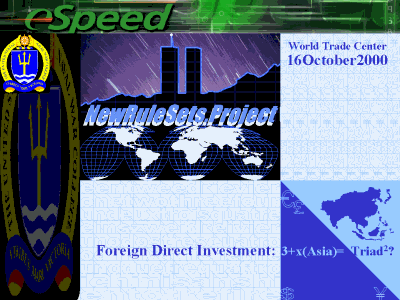
We designed the Foreign Direct Investment event with the following goals:
- Generate a "relationship profile" delineating how both Asia and the West must adapt past practices to meet the coming challenges of Developing Asia's huge demand for foreign direct investment (FDI)*
- Explore the key scenario variables and dynamics likely to emerge as Developing Asia's FDI requirements balloon in the coming years, focusing on the need for viable rule sets underpinned by a stable regional security environment
- Determine which political-military instability scenarios present the greatest potential to ruin Developing Asia's FDI climate
- Construct realistic downstream scenarios (covering the next 10 years) capturing Developing Asia's movement toward, or away from, a shared FDI rule set with the world's leading economies (i.e, the Triad of the U.S., EU and Japan "squared" to include a fourth leg—Developing Asia).
The one-day workshop (16 October 2000) was held at the Windows on the World restaurant atop the World Trade Center One. The host for the event was the online securities broker-dealer, eSpeed, represented by Adm. William Flanagan, USN (ret.), Senior Managing Director of the parent company, Cantor Fitzgerald, as well as Dr. Philip Ginsberg, Executive Vice President.
* For the purposes of this decision event, we defined Developing Asia as including: Afghanistan, Bangladesh, Brunei, Cambodia, China (to include Hong Kong and Macau), India, Indonesia, Laos, Malaysia, Maldives, Mongolia, Myanmar, Nepal, North Korea, Pakistan, Philippines, Singapore, South Korea, Sri Lanka, Taiwan, Thailand, and Vietnam. These countries constitute the category of South, East and South-East Asia as defined in the United Nations Conference on Trade and Development’s (UNCTAD) annual World Investment Report, which serves as the source for much of the global FDI data presented in this report.
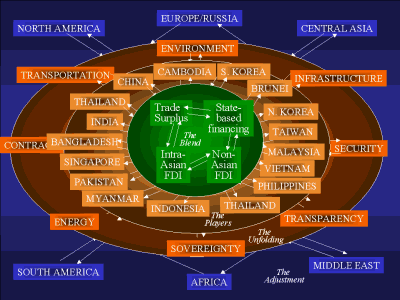
The Foreign Direct Investment event basically explored, over five substantive sessions, a rough "influence net" model that we constructed to describe the key dynamics of Developing Asia’s ability to attract outside investment and that flow’s long-term impact on the global economy and security environment:
- Concerning "The Blend," we conducted two sessions. In the first session called "Where Asia Gets the Money," participants were asked to determine the likely global pool of FDI stock for the year 2010 and then, through a series of "drill down" votes, determine how much of the total global pool would likely end up in Developing Asia. In the second session called "Energy Case Study," we reviewed the findings from the Asian Energy Futures event and asked participants to brainstorm reasons why state governments in Developing Asia should play a lesser or larger role in developing the energy sector.
- Concerning "The Players," we conducted one session called "Build Your Own Free Trade Zone." This voting process was based on the same logic of "connectivity" that fuels the popular movie trivia game known as Six Degree of Kevin Bacon, or The Kevin Bacon Game. In this effort, we asked participants to build three separate free trade zones, and then, by comparing the three groups, drew some conclusions about which Developing Asian states offer the greatest financial connectivity to the region as a whole.
- Concerning "The Unfolding," we conducted two sessions. In the first session called "Pick Your Dream Investment Partner," we had participants brainstorm ideas about what makes Developing Asia more or less attractive as a target for FDI, as well as what makes the U.S., the European Union and Japan more or less attractive as Developing Asia’s sources of FDI. This session was based on the 1960s American television game show called The Dating Game. In the second session called "Scenario Flashpoint," we examined how a future collapse of the North Korean regime would impact the region’s overall FDI climate, with our participants writing advisory emails to various involved political leaders.
- Concerning "The Adjustment," we conducted one session called "Rule Set Scenarios." In this voting process we asked the participants to name and populate—using "Headlines from the Future" —a quartet of long-term FDI climate scenarios for Developing Asia.
All of these participant brainstorming and voting sessions were captured by the GroupSystems software program for our subsequent analysis, along with our notes of the accompanying discussions. Collectively, this material forms the basis for the analysis we present in this report.
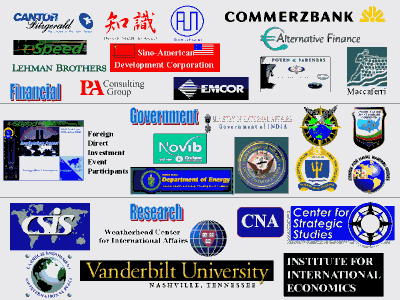
The following individuals participated in the day-long workshop:
- Mr. Mark Arens, U.S. Joint Forces Command
- Dr. James Auer, Vanderbilt University
- Mr. Guy Caruso, Center for Strategic and International Studies
- Mr. James Caverly, Department of Energy
- VAdm. Arthur Cebrowski, USN, U.S. Naval War College
- Mr. Thomas Cunningham, Emcor Group
- Dr. Peter Dombrowski, Center for Naval Warfare Studies
- Mr. Mike Feeley, Sino-American Development Corporation
- Adm. William Flanagan, USN (ret.), Cantor Fitzgerald/eSpeed
- Dr. Philip Ginsberg, Cantor Fitzgerald/eSpeed
- Mr. Jeffrey Goetz, Poten and Partners
- Dr. David Harries, Waterpeople Inc./Maccaferri Consulting
- Mr. Russell Hayward, Dynamic Strategies Asia
- Mr. Jeff Huang, Golden Calf Capital
- Dr. Gary Hufbauer, Institute for International Economics
- RAdm. Michael McDevitt, USN (ret.), Center for Strategic Studies/CNA
- Mr. Edward McDougal, Lehman Brothers
- RAdm. Barbara McGann, USN, U.S. Naval War College
- Mr. Jim Miller, Hagler Bailly
- Deputy Under Secretary of the Navy Charles Nemfakos
- Dr. Minxin Pei, Carnegie Endowment for International Peace
- Mr. John Pike, Zentrale Commerzbank AG
- Dr. Jonathan Pollack, Center for Naval Warfare Studies
- Mr. Lucian Pugliaresi, LPI Consulting Inc.
- Ms. Smita Purushottam, Ministry of External Affairs (India)/Weatherhead Center
- Dr. Leif Rosenberger, U.S. Pacific Command
- Ms. Elisabeth Scheper, Netherlands Org. for Internat’l Cooperation/Weatherhead Center
- Capt. Peter Swartz, USN (ret.), Center for Strategic Studies/CNA.

This graphic serves as both table of contents for the presentation of analysis and as a rough theoretical model for the NewRuleSets.Project as a whole.
On the question of the future of foreign direct investment in Asia, we break the process down into five distinct stages (moving from left to right across the graphic):
- We begin with the Here and Now time period, which encompasses the Starting Line environment (i.e., current global FDI market), the inevitably larger flows of FDI from the major global sources to Developing Asia (Triad to Quad?), and the dialectical relationship between the size of the global FDI Pie (i.e., do global FDI flows slow or speed up?) and how much of that global pool actually makes it into Developing Asia (Do the Math).
- Moving from the Here and Now into New Rule Sets, we describe the transition point as a sort of Dating Game between Developing Asia’s three great external "suitors" (North America, Europe, Japan), using this paradigm to explore notions of what makes for an "attractive" long-term FDI relationship.
- In the New Rule Sets time period, rather than trying to present an all-encompassing theoretical model of how various potential pathways unfold, we offer instead a "black box" model, or Scenario Dynamics Grid that displays a matrix listing the key economic, political, technological, cultural, environmental, and security dynamics involved in Developing Asia’s effort to attract FDI. As a dialectical expression of those scenario dynamics, we define the evolution of Developing Asia’s FDI environment as a struggle between the forces of transparency (New Laws) and the region’s continuing inability to move away from Old Orders, or that which keeps Asian capitalism an idiosyncratic model of the global brand.
- Moving from the New Rule Sets to the There and Then, we describe the transition point as a series of Tipping Points, or paradigm shifts that we think Asia must undergo before being able to achieve its maximum potential as a global magnet for FDI.
- In the There and Then time period, we present an X-Y axis with four major outcome scenarios, or Landing Paths, fleshing this framework out with a a series of possible sign posts (projected newspaper headlines) for both positive (Good Signs) and negative (Bad Signs) outcome scenarios. We wrap up this model with The Kevin Bacon Game, which has us exploring the concept of which Developing Asian economies are the "most connected" players in the global FDI game.
We begin our analysis with the Starting Line.
IV: Starting Line Analysis
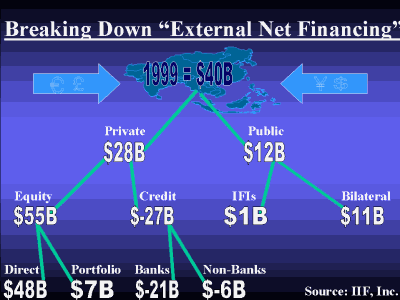
This slide shows where FDI sits within the universe of financial flows into and out of Developing Asia (1999) and demonstrates why we chose to focus on just direct investment as we looked ahead to the region’s economic future. First, let’s break down the numbers:
Developing Asia self-finances to the tune of about 40 to 50 percent of its investment needs. So when these countries need money, they can basically count on one another for roughly half of it. The rest of their external net financing comes primarily from three main sources: Japan, the EU and the United States. In 1999, the net flow was approximately $40 billion.
Of that $40 billion, almost three-quarters came from private sources, while just over a quarter came from government entities. This breakdown gives you a sense of the relative importance of the private sector versus the public sector.
On the public side of the ledger, very little actually flowed from the International Financial Institutions (IFIs) such as the International Monetary Fund or World Bank. Most (over 90 percent) originated from bilateral aid agencies such as the U.S. Agency for International Development. These numbers give you a sense of the relatively narrow role played by IFIs.
On the private side of the ledger, there was a large outflow of credit, or previously loaned funds. This flow represents several countries (e.g., South Korea, Malaysia) paying back loans that were extended to them during the Asian Flu of 1997-98. Most of this money was loaned by commercial banks.
Also on the private sector side, there was a huge inflow of equity investments. A small portion of that focused on portfolio investments, or the region’s stock markets, but the vast bulk of that flow involved direct investments—meaning foreign entities actually purchasing assets or existing firms.
We chose to focus on FDI because it is usually more strategic and long term in nature, typically involving transnational corporations or small and medium-sized companies setting up overseas operations. Whereas portfolio investments and loans are far more volatile, FDI reflects the global investment community’s appreciation of the region over the long haul. Also, unlike loans, stocks, or foreign aid, FDI involves actual ownership, meaning it is a far less liquid form of investment suggesting cross-border economic integration.
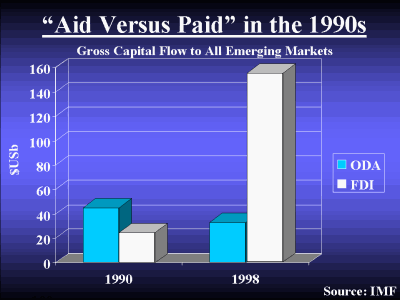
Here we look more closely at the relative importance of public sector foreign aid (ODA, or Official Developmental Aid from the Organization of Economic Cooperation and Development, or OECD) versus FDI for emerging markets.
During the Cold War, ODA substantially outpaced FDI as a source of external financing for developing economies. Even as late as 1990, ODA flows were roughly double that of FDI. In that economic paradigm, IFIs like the World Bank and bilateral donor agencies like USAID were major players in deciding which developing economies would receive the most attention.
This paradigm was turned on its head quite rapidly over the course of the 1990s, suggesting a very different, or new rule set regarding external financing of emerging markets. By the end of the decade, FDI was routinely outpacing ODA by a five-fold margin, effectively pushing the IFIs and bilateral agencies to the margins of the developing world—or to the truly undeveloped economies. Meanwhile, transnational corporations (TNCs) became the great arbiters of the designation "emerging," for TNC-fueled direct investment now represents the largest component of external resource flows to developing countries. According to the United Nations, the world’s average annual FDI outflow for the late 1990s (1995-99) was four times as large than a decade earlier (1985-89).* Simply put, FDI is now one of the most powerful variables of the global economy.
* All references to United Nations figures on FDI are drawn from the UN Conference on Trade and Development’s (UNCTAD) World Investment Reports, various years. Global FDI outflows for the years 1995-99 averaged $540 billion compared to $136 billion for the years 1985-89.
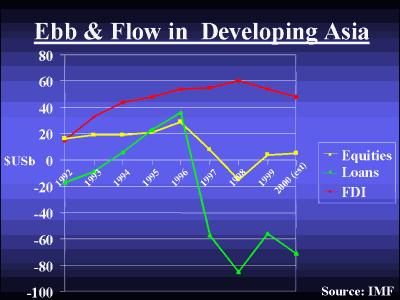
In this slide we explain why we chose to focus on FDI stock (i.e., the accumulated total) versus annual flow.
The chart above compares the net flow of portfolio investments, loans, and FDI into Developing Asia over the 1990s. Looking at stock investment and loans, it is not hard to spot the Asian Flu of the late 1990s, as both lines suffered significant—and in the case of loans, severe—net outflows following its onset.
But looking at the annual flow of FDI, it is not at all apparent that any financial crisis occurred in the region in the 1990s. So while Developing Asia experienced some genuine volatility in both stocks and loans, FDI flows expanded smoothly across most of the decade. This means that at the end of the 1990s, an enormous accumulation of FDI had been achieved by Developing Asia. Unlike loans that have to be paid off at some point, or stock market flows that reverse at a moment’s notice, FDI represents a long term stake—something to be protected by the foreign firm that has put its money on the line.
We chose to focus on FDI stock because we think the accumulation of such direct investment in Asia’s economic future represents that region’s genuine integration into the global economy—a process so huge and unprecedented that it generates new rules for globalization as a whole. Simply put, by accepting long term foreign investments, Asia puts itself on a pathway of accommodating its particular economic rule set to that of the larger international economic community, represented here by Europe and the U.S.
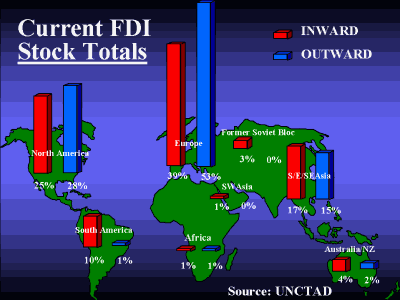
Now let’s look at the distribution of global FDI stocks by source (outward) and target (inward) regions.
Looking first at the inward stock, we get a sense of where TNCs like to invest, or which countries do the best job of attracting outside investors. What the world is really saying to your country when it invests directly in your economy is this: "We like your future market and we want to be a more permanent part of your success." In short, it is a seal of approval or a sign of long term confidence in a country’s internal rule set.
As the numbers above make clear, four regions of the world attract the vast majority of FDI (just over 90 percent):
- Europe (39%)
- North America (25%)
- South/East/Southeast Asia (17%)
- South America (10%).
Who are the great sources of that FDI? Here we look at outward stock totals and see that only three regions register in the double digits:
- Europe (53%)
- North America (28%)
- South/East/Southest Asia (15%).
What this charts makes abundantly clear is this: if Asia has to turn to the former Soviet bloc and the Middle East for energy, it has to turn to Europe and North America for the financial resources to make it happen.
V: The Here and Now of FDI in Asia

Having completed our cursory tour of the FDI landscape, let’s turn our attention to the unfolding of the Here and Now, which we define as the inevitable expansion of the current Triad of global FDI holdings (i.e., United States, European Union, Japan) into a downstream expression which we dub the future Quad (namely, the Triad + Developing Asia).
The concept of the Triad comes from UNCTAD’s 1999 World Investment Report, which described the concentration of global FDI stock in the U.S., Western Europe, and Japan as constituting a special, longstanding stronghold in the global financial community.*
* See UNCTAD, World Investment Report 1999: Foreign Direct Investment and the Challenge of Development (New York: United Nations, 1999), p. 22.
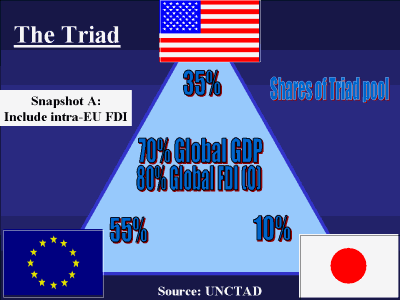
We like to describe the Triad as the financial embodiment of George Kennan’s Cold War strategy of containment, which focused on the U.S. denying the socialist bloc hegemony over Western Europe and Japan. Obviously, we succeeded in more ways than one, for not only did we deny the Soviets an opportunity to divide and conquer the West militarily, we likewise laid the cornerstone for the second great era of globalization by extensively linking these three pillars through foreign direct investment.
Not surprisingly, this chart likewise displays the two strongest bilateral military relationships in the international security environment:
- NATO, or the U.S. and Europe
- The U.S.-Japan security alliance.
In other words, FDI follows the flag even more than trade, because FDI represents long term relationships of trust, and these grow most easily between members of stable military alliances.
The Triad of the U.S., the EU and Japan constitute just over two-thirds of the world’s GDP. In this first snapshot of the Triad’s FDI holdings, we include the European Union’s intra-EU investments, which are sizeable. When we do so, the Triad’s share of global FDI outward stock is 80 percent.
Looking within the Triad itself, we recognize the EU as the largest source of FDI at just over half. But this snapshot is a bit misleading, for as the EU continues its process of integration, counting France’s FDI in Germany gets to be a little bit like counting Michigan’s FDI in Wisconsin. In this report, what really interests us is the amount of the West’s FDI assets that are available for cross-regional flows—namely, into Developing Asia.
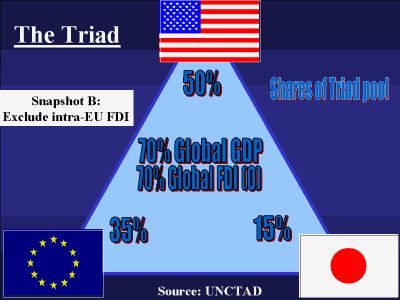
We gain a better sense of the relative weight of each leg of the Triad when we exclude the European Union’s intra-EU FDI. By lopping off that large amount from the EU’s FDI total (roughly half), we see that the Triad’s share of global GDP and FDI are equal. In this snapshot, it is easier to identify the United States as the world’s largest source of cross-regional FDI resources.
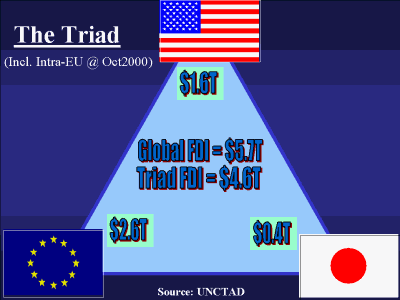
In this and subsequent calculations, we will include the European Union’s intra-EU investments because, for the foreseeable future, the EU remains an entity far closer to a multinational economic union than a federated state like the United States. This approach also (frankly) allows us to use UNCTAD’s FDI data without having to constantly estimate the intra-EU share.
Proceeding in this manner, we estimate the global FDI stock at $5.7 trillion as of October 2000. If the Triad holds four-fifths of that total, they control an aggregate pool of $4.6 trillion. Using the relative shares established by Snapshot A (EU = 55%, U.S. = 35%, Japan = 10%), we thereby estimate each leg’s holdings as follows:
- EU, $2.6 trillion, with roughly half invested within the EU itself
- United States, roughly one and a half trillion
- Japan, approximately $400 billion.
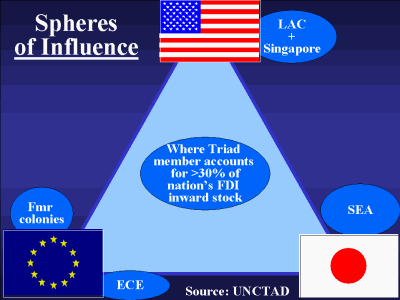
It is interesting to note that the Triad’s members each have their own little financial sphere of influence with regard to FDI. UNCTAD’s World Investment Report 1999 (p. 22) identified those countries in which the Triad "dominates," meaning those economies in which one of the Triad’s members accounts for "at least 30 percent of total FDI inflows during a three-year period."
Not surprisingly, much like security-based spheres of influence, these financial variants are based on geographic proximity and/or past colonial relationships (with one notable exception noted below).
The United States’ financial sphere of influence is centered almost exclusively on Latin America:
- Latin America = Argentina, Bolivia, Chile, Columbia, Costa Rica, Venezuela, Mexico, and Trinidad and Tobago
- Southeast Asia = Singapore (the noted exception).
The EU’s sphere of influence is clearly bifurcated between regional neighbors and former colonies:
- Former colonies = Brazil, Peru, Cape Verde, Egypt, Swaziland, Tunisia and India
- Regional neighbors = Czech Republic, Hungary, Poland and Turkey.
Japan’s sphere of influence is solely concentrated in Southeast Asia, meaning both neighbors and, in several instances, former WWII-era occupied territories:
- Singapore, South Korea and Thailand.
In essence, just as the containment triad represented a political reach extending beyond its immediate membership, its financial counterpart represents an economic whole that’s larger than the sum of its immediate parts.
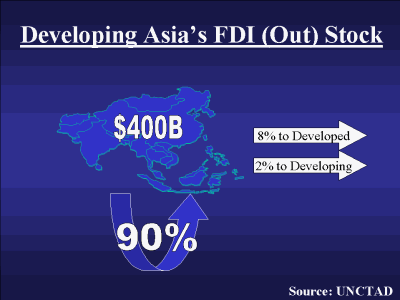
Now we turn to Developing Asia and what it brings to the table in terms of FDI outward stock.
Developing Asia’s current pool of FDI outward stock is roughly equivalent to that of Japan, or $400 billion. Using the latest UNCTAD data, we estimate that roughly nine-tenths of that total has been invested within the region itself, leaving only a tenth for distribution to the outside world. Of that 10 percent, the large majority goes to the Triad, and only a tiny fraction to emerging markets outside of Asia.
In effect, Developing Asia pretty much looks out for itself in terms of direct investment, and does not stray very far from home. That tendency, in combination with the substantial FDI provided by Japan, means that Developing Asia has limited—up to now—its reliance on Western investors to roughly one-third of its total FDI requirements. As developing regions go, this has been a relatively closed system in terms of Western influence.
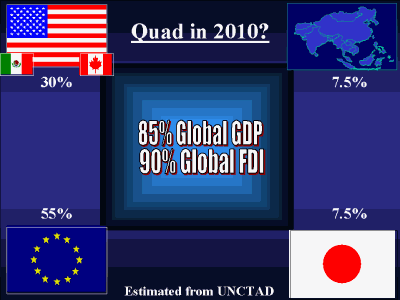
As a theme for the Foreign Direct Investment event, we proposed the emergence of a Quad by 2010, meaning:
- European Union (with any new members unlikely to alter its aggregate FDI total in any significant manner)
- North American Free Trade Area (United States, Mexico, Canada)
- Japan
- Developing Asia.
This expansion could be viewed as the next great step in a sort of post-containment strategy designed to:
- Bring Asia into the now-Western dominated community of developed economies
- By doing so, effectively rule out great power warfare in Asia in the same way it has been ruled out among the Triad members.
Such a Quad would be a formidable concentration of economic might, encompassing (as it does today) roughly 85 percent of the global GDP and 90 percent of the global FDI stock.* The individual shares of the Quad’s total FDI pool would be as follows:
- European Union, 55 percent (including its intra-union FDI)
- NAFTA, 30 percent (including its intra-area FDI)
- Japan, roughly 7 to 8 percent
- Developing Asia, roughly 7 to 8 percent (including its intra-regional FDI).
In many ways, the Quad must emerge in practice, if not in form, for Developing Asia to attract the out-of-region FDI it needs over the coming generation.
* The proposed Quad’s current share of global GDP is 85 percent. The GDP percentage shares of NAFTA and the EU would not change appreciably by 2010, while Developing Asia’s would rise slightly from today’s figure and Japan’s would decline slightly. These changes largely stem from demographic changes in Developing Asia (growing) and Japan (shrinking).
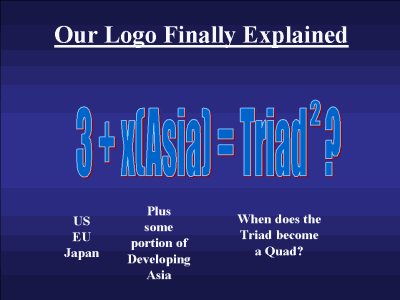
Having presented the notions of the Triad and Quad, we can now explain our somewhat cryptic, pseudo-mathematical decision event "formula":
- 3 refers to the Triad of the United States, the European Union and Japan, or what we like to call the financial embodiment of the Cold War strategy of containment, as well as the three main pillars of Globalization II.
- + x(Asia) refers to our proximate thesis that Developing Asia must turn increasingly to these three main sources of foreign direct investment over the coming years if their ambitious plans for economic development and energy consumption are to be realized.
- = Triad2? refers to our ultimate thesis that eventually Developing Asia will combine with the current FDI Triad to form a recognized Quad.
In terms of global financial architecture, this process is arguably the most important dynamic the world will witness over the coming generation. Naturally, new rule sets (e.g., politically codified expressions of consensus economic tenets) will be required for this process to unfold, but new rule sets will also be a downstream effect.
Where security fits in this argument is a complex question. Clearly, security relations between the legs of the Triad are very strong, forming the deep trust that allows these FDI bonds to form. Currently, many political-military analysts and decision makers in the United States are predicting that Asia will be the focus of interstate conflict in the coming decades. For this Quad to come into being, improved security relations within Developing Asia, and among all four legs of the quartet, is a minimum requirement. If the Quad is achieved in any real fashion, it will reduce the potential for great power war both within Asia and between Asia and the outside world to a considerable degree.
In effect, we argue that the primary strategic goal of the West should be to foster the security and economic integration of Developing Asia to the extent that it effectively joins a developed North that is committed to the long-term integration of free markets and democratic societies.

Having laid our vision for the progressive unfolding of the Here and Now, we now explore the dialectic tension between the amount of money the world has available for foreign direct investment and that share of The Pie that actually makes its way to the countries most in need—the so-called emerging markets. In this section, we asked our participants to Do the Math in a two-fold sense:
- Tell us how how much money the world will likely make available for cross-regional FDI flows over the coming decade
- Help us understand how much of that global pool would end up in Developing Asia, which in effect allows us to plot the strengthening and weakening of existing financial relationships both within Asia and between Asia and the outside world.
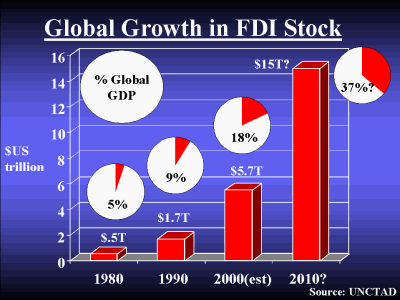
Before we took any votes on the subject, we presented participants with the following information regarding the explosive growth of global FDI outward stock over the past 20 years:
- In 1980, the global FDI outward stock was approximately half a trillion dollars. This amount represented 5 percent of the global gross domestic product of approximately $10 trillion.
- Over the 1980s, FDI flows averaged $120 billion a year, increasing the global FDI outward stock in 1990 to roughly $1.7 trillion, or 9 percent of the global GDP of $19 trillion.
- Over the 1990s, FDI flows averaged $400 billion a year, bringing the global FDI outward stock total in October 2000 to approximately $5.7 trillion. This amount represents 18 percent of the current global GDP of roughly $31-32 trillion.
In sum, global FDI outward stock has essentially tripled in both of the last two decades, or a ten-fold increase in all from 1980 to 2000. The FDI stock’s percentage share of the global GDP has basically doubled in both of the last two decades, or a 2 to 3 fold increase in total from 1980 to 2000. Annual flows of FDI has increased 10-fold from 1980 to 2000.
The total picture presented by this data suggests that FDI has become a profoundly important variable in the functioning of the global economy, both as an absolute amount and when measured against the world’s economic growth. For example, global outward FDI flows averaged 5 percent of gross fixed capital formation at the Cold War’s end, but rose to roughly 12 percent by 1998.
What we proposed for the next ten years was that the twin patterns (i.e., rough tripling in absolute stock and rough doubling of percentage share of global GDP every decade) would extend themselves one more time. If this were to occur, the global FDI outward stock in 2010 would be approximately $15 trillion, or 36 to 38 percent of expected global GDP. The annual average flow of FDI required to achieve this growth is approximately $900 billion. For comparison’s sake, the 1999 FDI flow was $800 billion, and in 2000 it was $1.1 trillion. The Economist predicts a drop to roughly $800 billion in 2001 (24 February 2001, p. 80).
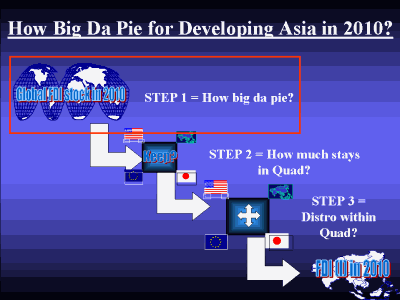
This slide lays out our four-step process for Doing the Math on the likely growth of FDI inward stock for Developing Asia by 2010:
- Our participants voted on the global total of FDI outward stock for the year 2010. Noting that the current global total was just under $6 trillion, we gave the participants a range of 5 to 15 trillion US dollars (constant), instructing them to pick a whole number.
- Having then determined the Quad’s share of the global total (using the previously established estimate of 90 percent), our participants voted on the percentage share of the Quad’s total that would remain within the quartet, i.e., invested in one another.
- Having established how much of the global total would be kept within the Quad, our participants next voted on the likely distribution of the Quad’s pool among its four members.
- Finally, we determined the likely inward stock of Developing Asia’s FDI for the year 2010 by adding up the estimated FDI stock totals flowing from:
- United States to Developing Asia
- European Union to Developing Asia
- Japan to Developing Asia
- Developing Asia to itself.
The point of this effort was not to come up with the most accurate forecast of FDI flows, but to force the participants to confront their own expectations about the future functioning of the global economy and their assumptions regarding the ability of the West to pull Asia into a closer, more integrated financial relationship.
We begin the process with the first vote on global FDI outward stock in 2010.
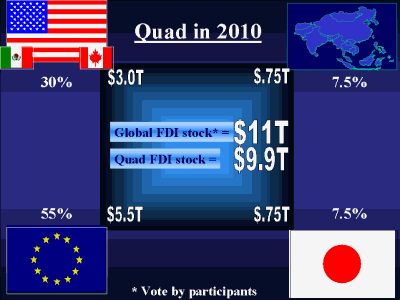
Our participants voted for a global FDI stock of $11 trillion, or a rough doubling of the current (October 2000) global stock. Considering the decline of global equity markets since the decision event last fall, this prediction may strike some as still unduly ambitious, despite the resistance of our participants to embrace the notion of another tripling of the stock amount.
Let’s put this vote in some perspective. First off, global FDI annual flows could drop to roughly $500 to 550 billion and still reach the $11 trillion mark, meaning annual flows could average roughly half of 2000’s record flow of $1.1 trillion. So, in many ways, this vote represented a certain pessimism about the future, despite the prediction of a doubling effect.
Secondly, a 2010 FDI stock total of $11 trillion would represent just over a quarter of the predicted global GDP of $41 to 42 trillion—far from a doubling of today’s percentage share of 18 percent.
Finally, as a point of comparison,we note that the Economist Intelligence Unit (EIU) has just published a report (February 2001), entitled World Investment Prospects, which they claim is the first detailed global forecast of FDI flows. In this report, the EIU predicts a global FDI outward stock total of $10 trillion by the year 2005. This would equate to an average annual flow of $900 billion, or a flow roughly 60 percent heavier than what our group of participants predicted.
If the Quad, as we predict, holds 90 percent of the global FDI stock in 2010, then its combined total would be just under $10 trillion. The totals for each leg of the Quad would be as follows:
- NAFTA, 30 percent or $3.0 trillion
- EU, 55 percent or $5.5 trillion
- Japan, 7.5 percent or $750 billion
- Developing Asia, 7.5 percent or $750 billion.
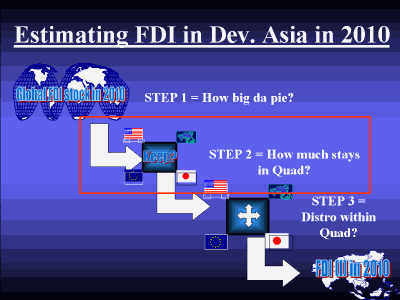
Having voted on the size of the global FDI "pie" for the year 2010, we next asked our participants to determine the likely share of the Quad’s total FDI outward stock that would remain within the quartet. In effect, we asked them to think ahead to how much the Quad members would choose to concentrate their FDI in one another vice the rest of the world.
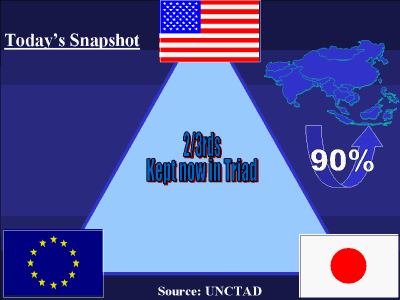
In preparation for this vote, we informed participants that the Triad members currently keep approximately two-thirds of their pooled FDI outward stock within the Triad itself (i.e., invested in one another and, in the case of the EU, within the Union itself).
We also reminded participants that, on average, Developing Asia states invest upwards of 90 percent of their outward FDI flows in one another.
In this vote, we asked participants to make a number of simultaneous decisions:
- How the current distribution within the Triad’s three legs would change with the addition of Developing Asia
- How much Developing Asia might redirect its FDI outward toward other Quad members versus how much it would likely keep for itself
- How much remaining FDI each member of the Quad would employ outside the quartet, or to the rest of the world (e.g., Latin America, former Soviet bloc, Southwest Asia, Africa).
Accounting for Mexico and Canada in NAFTA’s total.
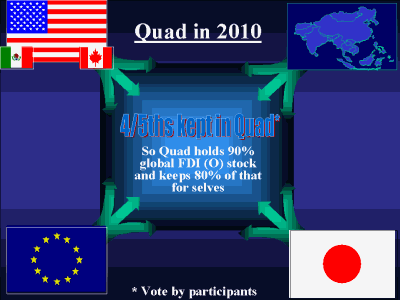
In this second vote, our participants voted to keep roughly 80 percent of the Quad’s predicted 2010 FDI stock pool of $10 trillion within the quartet, or approximately $8 trillion. This represents a higher percentage of concentration than that currently seen within the Triad, but that only makes sense given the tremendous economic opportunity represented by Developing Asia over the coming decade, and the fact that Developing Asia adds roughly 4 billion people to the mix.
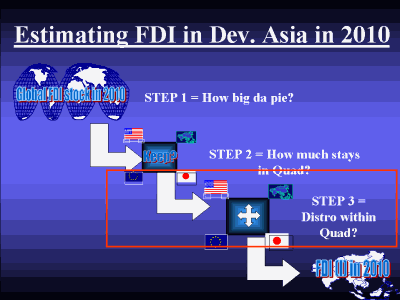
After deciding how much of the Quad’s FDI total will remain within the quartet, we asked the participants to decide how the pool would likely be distributed among the four legs over the next decade. In effect, we asked them to think ahead to how much the Quad members would choose to concentrate their FDI in Developing Asia vice the other legs—and the rest of the world.
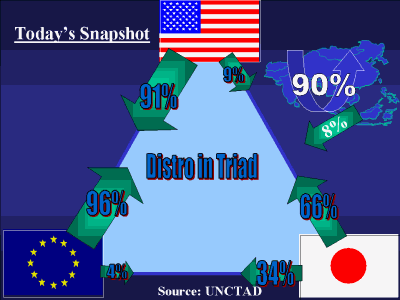
In preparation for the third vote, we informed participants of the current breakdown in FDI stock percentages for each leg of the Triad:
- The strongest bond obviously exists between Europe and the United States, as both direct over 90 percent of their in-Triad FDI total to one another.
- In contrast, neither the EU nor the United States seems able to achieve much direct investment in Japan, which, by all descriptions, throws up a lot of formal and informal barriers to inward FDI flows.
- Japan’s outward FDI is the most evenly distributed within the Triad, with approximately two- thirds going to the U.S. and one-third to the European Union.
In many ways, it is fair to describe the Triad as an incredibly strong dyad with a third leg that clings to both.
Finally, we reminded our participants that Developing Asia currently directs only a small fraction of its FDI outward flows to developed economies.
The one thing we did not provide the participants were current estimates of each Triad members FDI flows to Developing Asia, preferring to let them "guesstimate" those flows on their own.
This last vote was the most complex of the three, but in many ways, all we were asking the participants to do was to tell us which dyad relationships within the proposed Quad would grow stronger in terms of FDI flows over the next decade and which would grow weaker.
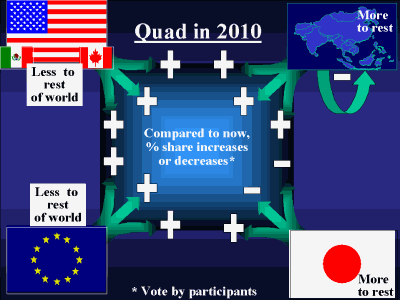
Rather than present percentages here, we delineate which dyad relationships grow stronger (measured against today’s estimated percentage shares) over time and which grow weaker.
For NAFTA, the participants voted for stronger dyads with all three Quad partners, meaning less FDI available for the rest of the world. The same basic judgment was offered for the European Union.
In Japan’s case, the group voted for a stronger FDI relationship with only the EU, envisioning a smaller percentage of Japan’s FDI flowing into North America (presumably because it is hard to imagine us investing any less in Japan given how little we do today) and Developing Asia. As a result, a greater share of Japanese funds would be made available for the world outside the Quad (e.g., former Soviet bloc, Mideast, Latin America).
As for Developing Asia, the group basically predicted an opening up of the region’s heretofore "closed" FDI loop, meaning far higher percentage flows to all other Quad legs, as well as to the world outside.
We believe we can draw three basic conclusions from this vote:
- Even a strong reorientation of Western investment toward Developing Asia is unlikely to weaken the already formidable trans-Atlantic FDI bond.
- A strong reorientation of U.S. investment toward Developing Asia may weaken some of our financial connectivity with Japan, in large part because they do not yet allow us into their economy in a meaningful way.
- A strong reorientation of Western investment toward Developing Asia is likely to free up Asia FDI for redirection to other parts of the world.
In sum, when the West invests in Asia it helps to integrate that region into the global economy on two levels: by tying the West closer to Asia and by tying Asia closer to the rest of the world.
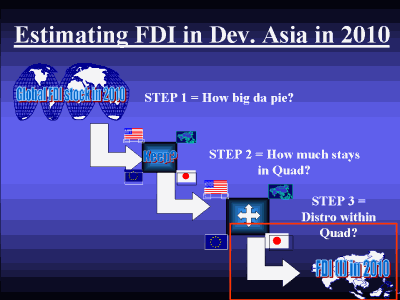
Having completed our three "drill down" votes, we are now able to calculate our workshop’s estimate for the likely available inward stock of FDI in Developing Asia in the 2010 timeframe. This calculation is not presented as a "scientific forecast"—something better obtained from an industry group or The Economist Intelligence Unit—but rather as a bias-revealing vote by a cohort of experts covering the issue from political, economic and security angles.
A second point to remember about this calculation is the timing of the vote in relation to market trends. As of mid-October 2000, the market decline was already in full swing, although the full extent of the bear market was not yet in view. Accordingly, it is fair to say that this group vote was not taken by those still caught up in the so-called high-tech bubble of 1998-2000, nor by those unduly depressed by the markets’ rapid decline in the first half of 2001. Nonetheless, this entire voting scheme must be viewed as nothing more than the collective opinion of some smart people one morning in the fall of 2000.
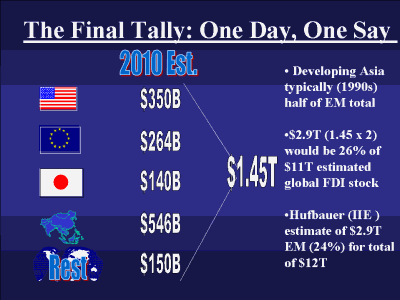
Using our "drill down" voting process, we finally arrive at the following estimated figures for inward FDI stock available to Developing Asia in the year 2010.
Not surprisingly, our participants predicted that Developing Asia itself would provide the largest share of FDI, or between 35 to 40 percent of the total amount of $1.45 trillion. NAFTA would provide the second largest amount at just over a third of a trillion, then the EU with just over a quarter. Japan and the rest of the world would combine to provide approximately $300 billion, or one-fifth.
How do we interpret this combined estimated total of $1.45 trillion FDI inward stock for Developing Asia in 2010?
First, we note that Developing Asia typically accounts for roughly half of the FDI flows into Emerging Markets. So if we double $1.45 trillion to get a $2.9 trillion total for all Emerging Markets, that would represent a 26 percent share of the global total ($11T) the group voted for previously. Such a percentage would be in line with historical averages. According to UNCTAD, Emerging Markets have typically garnered one-quarter of global FDI flows over the years.
Second, we will cite the particular vote of Dr. Gary Hufbauer of the Institute of International Economics, who recently completed a major study on world capital markets.* Hufbauer’s 2010 estimate for all Emerging Markets was $2.9 trillion, or 24 percent of his global FDI stock vote of $12 trillion.
In sum, we believe the participants’ votes are defensible both in terms of fitting within historical ranges and corresponding reasonably well to mainstream economic forecasts. Again, compared to the Economist Intelligence Unit, our group was fairly conservative, but we only expected that since we brought together a fairly wide range of expertise to discuss both future potential and future problems.
* Wendy Dobson and Gary Hufbauer, World Capital Markets: Challenge to the G-10 (Washington DC: Institute of International Economics, 2000).
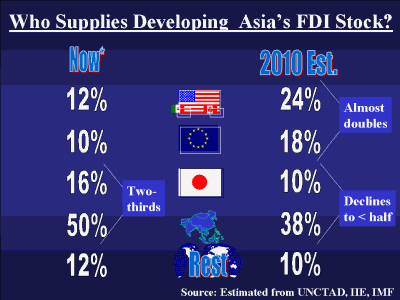
By any fair estimate, our vote was somewhat rigged. After all, our starting premise for the workshop was Developing Asia’s need to attract more FDI from the West over the coming years to accomplish its ambitious growth targets. So it’s no surprise that our voting process indicated that experts expect more Western investment in Asia in the future.
The question we were really searching to answer here was: How much might the West’s relative financial influence in Developing Asia increase? In effect, if Asia can continue to self-finance to a large degree through intra-Asian FDI, state-based financing, internal savings, and trade surpluses, then the West’s ability to draw Asia toward a single global rule set is limited.
What do we then draw from this session?
- Right now we estimate that the West has cumulatively provided just under a quarter of Developing Asia’s inward FDI stock, compared to the two-thirds that Asian themselves (Japan included) have supplied.
- Based on this voting process, we believe Developing Asia is transitioning to a new reality in which extra-regional providers will come to dominate the FDI market.
- Over the next decade or so, we foresee the West’s position in Developing Asia’s inward FDI stock roughly doubling from its current percentage share.
- While it would be naïve to equate a rough doubling of percentage share with a doubling of financial "influence," it does seem fair to say that the West’s economic influence in Asia will rise dramatically over the coming years as a result of further financial integration brought on by a combination of globalization and Developing Asia’s extraordinary need for foreign investment.
Of course, what cannot be extrapolated from this simple exercise is the answer to the eternal question about the chicken and the egg, which we paraphrase here: Does the West’s rising economic influence lead to the emergence of new rule sets in Asia or must new rule sets arise in Asia for the West’s economic influence to grow?

Where does this vote leave us following the great decline in equity markets in early 2001 and the resulting slowdown in the global economy? How much stock (pun intended) can we place in this sort of projection?
Again, we like to emphasize how modest our group’s projection actually turns out to be when compared to recent history.
Developing Asia ended the 20th Century with an inward FDI stock total of about three-quarters of a trillion dollars. To achieve a 2010 stock total of $1.45 trillion, the region would need to attract around $70 billion a year (counting both intra- and inter-regional flows). $70 billion equates to roughly the average inward flow of the mid-1990s, or substantially less than what poured in during the heyday of the high-tech bubble in stock markets at the very turn of the century.
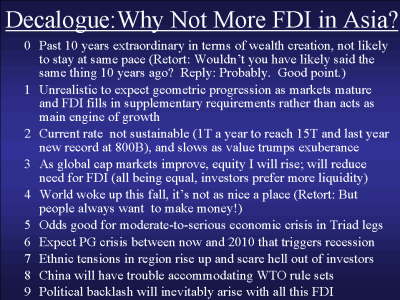
During this voting process, we took time out at several occasions to ask participants to brainstorm reasons why they might be wrong in their collective guesstimate of $11 trillion in global FDI stock for 2010. This slide presents ten of the best arguments we heard about why there won’t be a larger FDI flow into Developing Asia over this decade.
The arguments can be grouped into four general camps:
- The 1990s were extraordinary, and past performance does not guarantee future results.
- There is a natural ceiling on FDI: at some point more mature market venues appear and investors will prefer them for their increased efficiency and ease
- The global economy is due for some breakdowns, crises, snafus.
- Developing Asia is simply ill-equipped to absorb all this investment without destabilizing outcomes.
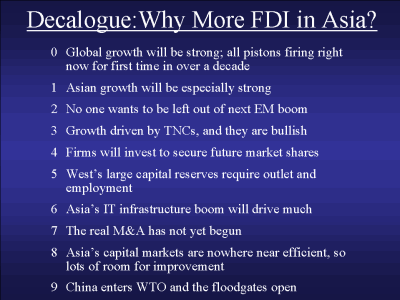
Here we present the flip side arguments, or why there very well could be a bigger FDI flow into Developing Asia than we’re envisioning.
The arguments can likewise be grouped into four general camps:
- The global fundamentals are in good shape; this is just a necessary pause in the action.
- Transnational corporations are the big drivers here, and they see a big market they want to be part of (think about a middle class of perhaps a billion people!).
- If there is a natural ceiling on FDI, Asia is a long way away from it, given the immaturity of their financial markets.
- Asia is opening up and working on new rules, so the long term looks very solid.
By presenting these alternative analyses, we give you a sense of the range of opinions that came together in three, very particular votes. In short, we had a full complement of both bulls and bears.
VI: The New Rule Sets of FDI in Asia

Moving to New Rule Sets, we shift gears from number crunching to a norm-oriented brainstorming exercise where we explore the notion of what makes a region an "attractive" FDI partner, in terms of either providing or receiving investment flows.
We dub this workshop session "The Dating Game," after the 1960s American television game show of the same name.

The original version of "The Dating Game" debuted in December 1966 and immediately became a major game show hit on American television.
During its seven-and-a-half year daytime run on the ABC network, earning a distinction as the 31st longest running television game show in history, the program set up some 3,000 dates for contestants. Appearances on the show helped launch the fledgling careers of numerous actors who later became major television and movie celebrities, including Sally Field, Tom Selleck, Burt Reynolds, Arnold Schwarzenegger, and Steve Martin—to name a few.
The show was designed to feature two date selections during each half-hour program. The format was simple: three young men or women (the "contestants") sit on stage and vie for a date with a young woman or man (the "guest") who is hidden from their view. Only the host, the studio audience and the television audience could see both the guest and the contestants at the same time. Asking questions especially prepared to reveal the romantic nature of each contestant, the guest judges their responses to determine which one is best suited to his or her particular taste. At the end of each segment, the selected contestant joins the guest to share a prize date, which always includes a fun-filled weekend during which they travel to some desirable and romantic destination.
In effect, the Dating Game was an early form of what we now call reality-based television: the show replicates a real-life dynamic (choosing someone for a date) in an artificial environment for the entertainment value of simple voyeurism.

In our version of the game, we cast Developing Asia as the guest, with three contestants vying to win the FDI "date" that leads to a long term economic relationship:
- NAFTA
- European Union
- Japan.
And yes, as with any committed relationship, this one also involves a subtle mix of personal attraction (e.g., cultural ties), fear and loathing (security issues), interpersonal conflict (political controversies) and a desire for long-term financial security (it always comes down to money, doesn’t it?).
In this first round of questioning, the guest (Developing Asia) asks the three suitors to offer up what they think is their single best feature.
Having opened the game as such, we turned our participants loose with their laptops to brainstorm how each of the contestants might answer.
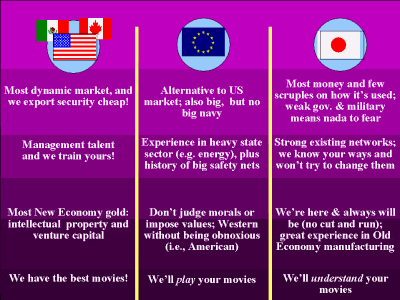
This slide presents a selection of the best ideas we received from our participants. They are grouped in trios along the following lines:
- The first row ("Most dynamic…," "Alternative to US…," "Most money…") focuses on a combination of sheer market capacity and the security muscle that comes with it. The U.S. is presented as the obvious leader in both categories, but Europe is seen as offering the same economic package without the additional national security "baggage." Japan is presented as the most liquid ("most money and fewest scruples") or easiest to deal with, since it does not represent a security challenge.
- The second row ("Management talent…," "Experience in…," "Strong existing networks…") focuses on management capacity. The U.S. is presented as the most forward leaning, while Europe is presented as the most experienced. Japan, once again, is presented as the easiest fit.
- The third row ("Most New Economy…," "Don’t judge…," "We’re here…") focuses on Developing Asia’s hopes and fears regarding globalization’s ultimate impact. The U.S. is presented as the leading edge of the New Economy, while Europe is contrasted for its ability to export Western efficiency without imposing "alien" values. Japan is contrasted even more as the "local boy made good," who is more like its neighbors than these upstart, New Economy-types from the West.
- The last row ("...movies!" "...movies," "...movies") focuses on cultural differences. The U.S. is seen as an egomaniacal exporter of culture, while Europe is contrasted for its sophisticated acceptance of other cultures. Japan, yet again, is presented as the insider who can really understand the local environment.

In this second round of questioning, the contestants are asked to reveal their least attractive feature as it relates to serving as a source for FDI. Here our participants brainstormed critical descriptions of all three economic players, as they might be viewed from the perspective of Developing Asia.
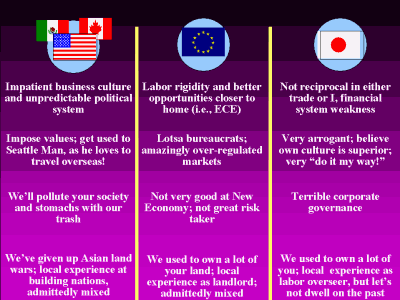
This slide presents a selection of the best ideas we received from our participants. They are grouped in trios along the following lines:
- The first row ("Impatient business…," "Labor rigidity to US…," "Not reciprocal…") lists the classic gripe about each economy’s business practices. The cliché on the U.S. is our lack of patience and our incomprehensible political system (to wit, the 2000 presidential election). The European cliché is the pampered, privileged German worker who’ll defend his eight weeks of vacation to his dying breath. Japan’s cliché focuses on its lack of reciprocity.
- The second row ("Impose values…," "Lotsa bureaucrats…," "Very arrogant…") explores the concept of business culture. The U.S. is blamed for Seattle Man and our tendency to moralize about other people’s "unfair practices." Europe is criticized for going overboard on rules, especially as the EU cracks down on union-wide standards for everything from beer to ball bearings. Japan is tagged for its well-worn mask of cultural superiority, which as of late has definitely shown signs of cracking.
- The third row ("We’ll pollute…," "Not very good…," "Terrible corporate…") zeros in on each system’s Achilles heel. America is the land of the lowest common denominator—a Hobbesian economic wasteland where everyone races to the bottom. Europe is an old fogey in a young man’s game, and clearly doesn’t have the stomach for hyper-competition. Japan’s corporations, once the envy of the world, are now despised by many as dinosaurs from another age.
- The last row ("…experience at building nations," "…experience as landlord...," "…experience as labor overseer...") gets at the worst historical baggage each side brings to the table in Asia. The U.S. is seen as the militaristic bully, Europe as the former colonial master, Japan as the unrepentant war criminal.

In the last round of questioning, the tables are turned on the Guest, and we ask our participants to brainstorm both compliments and criticisms of Developing Asia as a target for FDI.
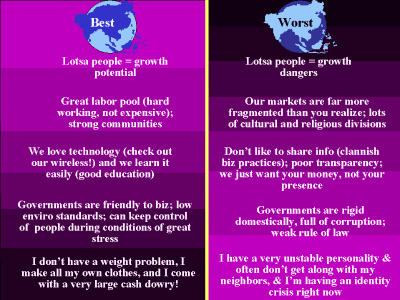
This slide groups the most interesting ideas in best-worst pairings:
- The first row ("…growth potential," "…growth dangers") gets right to the heart of the matter. When the international business community looks at Asia, the first thing they see are markets, markets, markets. It’s the bromide, "If I could just get every person in China to buy one . . .." But with that potentially massive market comes a demographic downside: Asians have already abused their environment mightily in their rapid industrialization. How much worse could it get when you combine all that population growth with mass consumerism?
- The second row ("Great labor…," "Our markets…") tackles two great clichés: Asians as hard- working (true, but what Emerging Market features lazy workers?) and Asian as one vast marketplace (when in reality Asia is a jigsaw puzzle of countless markets, each a little different from the rest). India is a good example on both counts. Non-resident Indians certainly do well abroad, suggesting that if the Indian government just got out of the way more often, India would have a lot more to offer the world. On the other hand, there is no more fractured market in the world, with its hundreds of languages and dialects.
- The third row ("We love technology…," "Don’t like to share info…") highlights the great irony of the region: the juxtaposition of great skill in information technology design and manufacturing and an almost culturally ingrained distaste for transparency. Outside of India, where is the press truly free in Asia?
- The fourth row ("Governments are friendly…," "Governments are rigid") targets governments which seem to specialize in maximizing control versus encouraging individual and corporate risk-taking. If China spent half as much time encouraging e-commerce as it does trying to keep its population under "mouse arrest," how much further ahead would that economy be in ten years?
- Finally, the last row ("I don’t have a weight problem…," "I have a very unstable personality...) cites arguments about the region’s historical maturity. Despite featuring some of the oldest continuous civilizations in the world, Asia features a lot of insecurity—both real and imagined—that detracts from its obvious positive attributes as a up-and-coming center of the global economy.

We now turn to the Scenario Dynamics Grid, which is our "black box" model of sorts. Here we seek to arrange, in a systematic fashion, those broad scenario elements that we think—in aggregate—offer us the majority of the explanatory power we need to analyze how this huge process of change unfolds over the coming years.
The scenario elements we cite here are obviously not the only ones in play, and we don’t pretend that this 3X6 matrix encompasses the universe of change that will be FDI in Developing Asia from now to 2010. Rather, we choose to focus on these 18 scenario elements because we think it’s important to tackle the subject with both vertical depth (i.e., drilling down through Waltz’s three levels) and horizontal breadth (i.e., our six global "lenses" of economics, politics, technology, culture, environment, and security*).
These 18 scenario elements are, so to speak, signposts directing us to where the change connected with the growing role of FDI in Asia’s economic development is most likely to be concentrated—in terms of causality. Naturally, the more we research the subject, the better our signposts become in terms of clarity, but for now, these are the best 18 scenario elements we can identify.
The scenario dynamics grid as a whole should be viewed as a sort of smorgasbord: we think all of these elements are potentially in play for all of the countries in question, but obviously each country’s path will be a selection of sorts from the larger menu of possibilities. As such, the grid is purposely defined in a rather generic fashion, so as not to concentrate too much explanatory power on just one country to the detriment of others.
* The six global "lenses" roughly correspond to Thomas Friedman’s notion of "six-dimensional" thinking about globalization, as expressed in his The Lexus and the Olive Tree: Understanding Globalization (New York: Farrar Straus Giroux, 1999), see the chapter, "Tourist With an Attitude," pp. 3-24.
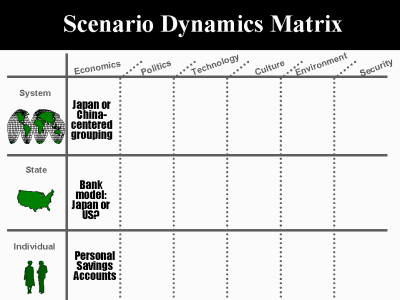
Beginning with the economic lens and focusing first on its nexus with the international system, we cite the fundamental tension between two possible future pathways: an Asian economic grouping that is Japan-centered or one that is anchored more by a rising China. The difference may be crucial not only for Western business interests, but U.S. national security interests as well. A Japan-centered grouping is more likely to favor a trans-Pacific orientation, while a China-centered one would likely remain captive to Beijing’s concept of "globalization on our terms."
In many ways, Japan is ahead on the learning curve, having already experienced the collapse of its state-dominant development model, whereas China’s may linger for years to come—or collapse soon enough from the rigors of international competition once it finally joins the WTO.* But eventually one country will emerge from that crucible, and whoever gets there first may well determine which country dominates the region over the long haul. For now, both are too weak to serve as the organizing principle of a truly integrated Asian market.
At the level of the nation-state, we note the all-important question of whether or not Asian economies move away from the Japanese banking model and toward that of the U.S. In a nutshell, Japanese banks, in collusion with the government, value firms more for their strategic relationships than their profit potential, leading to lots of bad loans to businesses that would otherwise falter in a more open marketplace. As a result, Japan’s banking crisis has dragged on for years now, while the U.S.’s Savings & Loan crisis of the late 1980s was dispatched with our usual harsh speed.**
Finally, on the individual level, we cite the potentially large role Asian personal savings accounts could play in the region’s investment future. Simply put, too much of Asia’s financial assets sit in do-nothing bank accounts when they could be employed in more efficient capital markets.
* On this subject, see Craig Smith, "Private Business in China: A Tough, Tortuous Road," New York Times, 12 July 2000, p. A1.
** For a good review of the crisis, see Stephanie Strom, "Rickety Japanese Banks: As Borrowers Collapse, Is New Bailout Needed?" New York Times, 8 September 2000, p. C1.
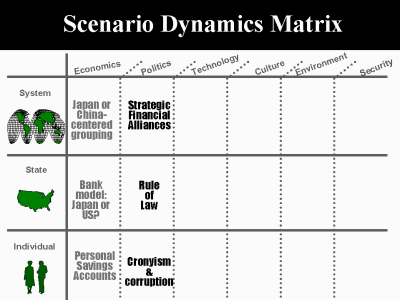
Turning to politics and focusing first on its nexus with the international system, we note the important role played throughout the region by Strategic Financial Alliances (SFAs). SFAs are prevalent in Asia because too many governments there simply do not get along well with one another. A classic example is Taiwanese airlines investing in their Chinese counterparts despite a ban on direct flights between the two countries. Often, SFAs work through a neutral intermediary, which is how a lot of investment flows into China via Hong Kong and Singapore—two linchpins in Asia’s SFA network. For example, two firms that otherwise would not join together are willing to do so if the right Singaporean firm steps in as a cornerstone in the alliance. In sum, SFAs represent international networking at its best: getting around the political roadblocks that too many governments put in the way of value-enhancing business partnerships.*
Dropping down to the nation-state level, we cite the obvious issue of rule of law. Few things scare away foreign investors more than judicial caprice, especially when it smacks of political motivation. Governments can facilitate a return on investment, but only a sound judiciary guarantees a return of investment when conflicts arise.**
Finally, and much in the same vein, we focus on cronyism and corruption at the level of the individual. It is the judgment of many experts that Asia simply has not "cleaned up its act" sufficiently as a result of the Asian Flu of 1997-98.*** While a few heavyweights disappeared in the financial earthquake (Indonesia’s Suharto the most prominent example), the culture of cozy business-government relationships persists throughout the region.
* Thanks to Dr. Minxin Pei for his inputs on SFAs.
** For a good description of this problem in China, see Erik Eckholm, "Judicial Caprice in China: 4 Families Share Stories," New York Times, 10 September 2000, p. A10.
*** On this subject, see Sheryl Wudunn’s chapter, "Reinventing Lives," in Nicholas D. Kristof and Wudunn, Thunder From the East: Portrait of a Rising Asia (New York: Alfred A. Knopf, 2000), pp. 143-62.
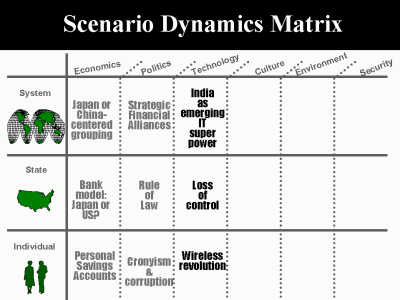
Turning to technology and focusing first on its nexus with the international system, we emphasize India’s emergence as a global information technology superpower. The country’s high-tech enclaves already account for roughly half the software written in the world today, an achievement that is not so surprising when you realize India has the largest pool of IT workers in the world. Then again, it also possesses the largest pool of illiterates in the world. In some ways, India matters most as an example to the rest of the developing world. If globalization succeeds in India, where half the population is terribly impoverished, then it can succeed just about anywhere. But if it can’t succeed in democratic India, with its booming IT sector, then where can it succeed?*
Moving to the nation-state level, we note the loss of control many Asian states are experiencing as a result of the Information Revolution. One good example is last year’s South Korean parliamentary election, when the Internet proved itself a political force. When political activists wanted to publicize past corruption by certain candidates, the timid mainstream press took a pass, only to find itself outflanked by the Web. Out of 86 candidates named in a corruption "blacklist," 58 lost in a stunning turn of events.** A second prime example is seen is the mobilization of Falun Gong members in China by the group’s reclusive, New York City-based leader, working primarily through postings on his website.***
Finally, on the individual level, we cite the coming wireless revolution in Asia, which is likely to transform social interactions there to an unprecedented degree. One reason why this revolution will advance so quickly in Asia versus the U.S. is that Asians never became addicted to "fat" visual content on the Internet in the same way that Americans have. As such, Asians are far more willing to adapt themselves to using handheld devices for real-time alphanumeric communications, moving them ever closer to the concept of an "Evernet" of 24-7-365 connectivity.****
* On India’s IT, see Anthony Spaeth, "India’s New Incarnation," Time, 27 November 2000, p. B2.
** See Doug Struck, "Internet Changed Culture of S. Korean Vote," Washington Post, 15 April 2000, p. A14.
*** On Falun Gong, see Elisabeth Rosenthal, "Beijing in Battle With Sect: ‘A Giant Fighting a Ghost,’" New York Times, 26 January 2001, p. A1.
**** On the Evernet concept, see Barnett, "Life After DoDth," and Thomas Friedman, "Brave New World," New York Times, 22 September 2000, p. A29.
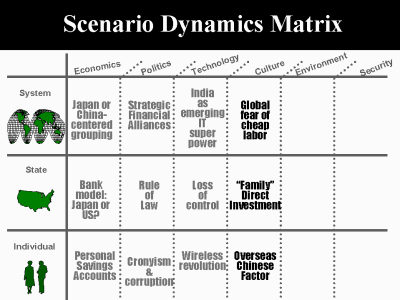
Shifting over to culture and focusing first on its nexus with the international system, we cite global fears regarding Asia’s cheap labor. Of course, this is a bit of a red herring, because if all it took to attract FDI was cheap labor, then Sub-Saharan Africa would attract the lion’s share, and this surely is not the case. Clearly, more than just cheap labor must go into the mix. But it is just as clear that Asia as a whole suffers from widespread underemployment, which is the real reason why labor remains so inexpensive. Simply put, many Asian workers are poorly utilitized in many sectors, where great gains in efficiency could be had, given the right blend of new rules and greater access to financial capital, which, in effect, work to free private firms from the influence of political powers more interested in preventing unemployment than maximizing growth potential.*
Dropping down to the level of the nation-state, we highlight the phenomenon of Asia’s clannish business structures, wherein a small number of families tend to control inordinate amounts of national economies in states such as Indonesia and the Philippines. In effect, these oligarghic market structures mean—as one of our participants put it—"a lot of FDI flowing into Asia is really ‘family direct investment’" that never escapes the grip of these powerful clans, thus limiting the potential multiplier effect in the economy as a whole.**
Finally, at the individual level we note the important variable represented by the overseas Chinese who work throughout the world, but are especially concentrated in the Asian region. They are important in a two-fold sense:
- Their remittances back to China are substantial, as are their estimated personal savings.
- Their presence in other Asian countries not only causes local concerns about a Chinese "fifth column," it also places these expatriates in the position of serving as convenient scapegoats during economic tumults.***
* On China, see Craig S. Smith, "Sharp Shift for China’s Economy as Entrepreneurs Woo Investors: New Rules Easing Companies’ Access to Capital," New York Times, 28 December 2000, p. A1.
** The top 15 families in Indonesia control over 60 percent of the corporate assets; in Philippines and Thailand it is between 50 and 60 percent. Other countries registering 25 percent of higher include Malaysia, Singapore, and South Korea. This data is cited in Andreas Kluth, "A Survey of Asian Business: In Praise of Rules," The Economist, 7 April 2001, p. 6.
*** This was most obviously the case in Indonesia following the onset of the Asian Flu; for an overview of this situation, see Brian Barry, "A Survey of Indonesia: The Faltering Firefighter," The Economist, 8 July 2000, pp. 1-16.
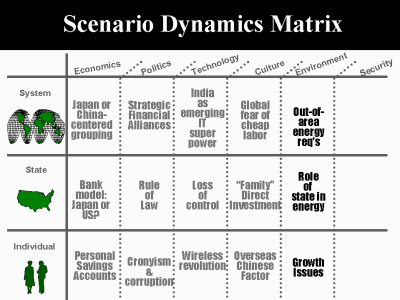
Switching to the environment and and focusing first on its nexus with the international system, we cite Asia’s growing out-of-area energy requirements. The region approaches self-sufficiency only in coal. In natural gas, where requirements are expected to roughly triple over the next two decades, Asia must increasingly turn to the former Soviet bloc and the Middle East, since advanced economies in the region already buy up the lion’s share of what’s produced locally. In oil, Asia’s requirements for out-or-region imports are predicted to double by 2020. Asia already buys up roughly two-thirds of all oil produced by the Persian Gulf region, and will buy approximately three-quarters as early as 2010. These dynamics create a co-dependent relationship between Asia and the energy-rich regions of the Persian Gulf and Central Asia: Asia is increasingly dependent on the political-military stability of these regions, and these regions are increasingly dependent on the economic stability of Asia.*
Moving down to the level of the nation-state, we focus in on the role of the state in the energy sector. One of Wall Street’s great concerns about the future of energy in Asia is the disproportionate mix of public decision making and private finance—namely, too much of the former controlling the latter. The historical record of state energy planning around the world is rather dismal, and yet, in the case of Asia, the states that will experience the most rapid increases also feature the heavy hand of state control.** In sum, while Wall Street likes to see monopolies build networks, it prefers them to be run by market forces once they are operational.
Finally, on the level of the individual, we note the general environmental issues connected with all this rapid growth. It is fair to say that Asia’s infrastructural requirements over the next two decades are unprecedented in human history. The combination of rapid rises in energy consumption, population, urbanization, and water usage will further damage an already battered regional ecosystem.***
* For a good overview of this connectivity, see Robert A. Manning, "The Asian Energy Predicament," Survival, Spring 2000, pp. 73-88.
** For a good description of Enron’s difficulties in the Indian electricity market, see Celia W. Dugger, "High-Stakes Showdown: Enron’s Right Over Power Plant Reverberates Beyond India," New York Times, 20 March 2001, p. C1.
***For good analysis on this subject, see National Intelligence Council, Global Trends 2015: A Dialogue About the Future With Nongovernmental Experts, NIC 2000-02, December 2000, .
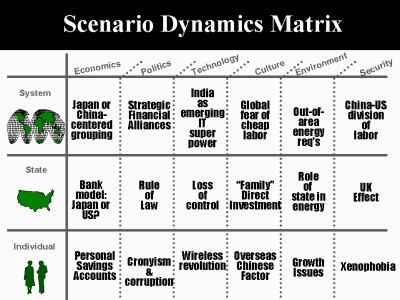
Finishing with security and turning first to its nexus with the international system, we will argue that there exists in Asia a division of spheres of influence between China and the United States.* In effect, China is the dominant mainland power in the region, while the U.S. is the dominant maritime power. By and large this regional balance of power has been stable, with occasional lapses into mini-standoffs such as the 1996 controversy over Taiwan or this year’s surveillance plane imbroglio. But on a bilateral basis, it is fair to say that both sides have spent most of the 1990s coming to the conclusion that the other power constitutes the main threat to peace in the region.** How this military relationship unfolds over the coming years will go a long way in determining the region’s security environment.
Downshifting to the level of the nation-state, we cite the "UK effect," as in, United Korea. No single change to the region’s security landscape over the coming years will be more profound than the eventual reunification of the Korean peninsula. With the inevitable demise of the North Korean regime, the potential for a major land war in Asia will be immediately and significantly reduced. Two questions arise about this scenario: the speed of the collapse (fast versus slow) and the nature of South Korea’s response (can it just "buy out" Pyongyang or must it go in and literally take over the country?). Naturally, the best outcome in terms of the FDI climate is a slow collapse where Seoul "buys out" the North Korean regime in piecemeal.***
Finally, on the level of the individual, we cite the issue of Asian xenophobia about Western companies coming in and buying up big chunks of the economy, thus replicating, in some sense, a colonial-era atmosphere of "distant owners." This tendency to "blame the West" was also seen in the Asian Flu of 1997-98.****
* Thanks to RAdm. Michael McDevitt, USN (ret.) for this concept.
** On this trend, see Thomas E. Ricks, "For Pentagon, Asia Moving to the Forefront," Washington Post, 26 May 2000, p. A1, and John Pomfret, "U.S. Now a ‘Threat’ in China’s Eyes: Security and Taiwan Issues Lead to Talk of Showdown," Washington Post, 15 November 2000, p. A1.
*** During the FDI decision event, we asked the participants to vote on which of the four possible scenarios (established by the two questions cited above) they believed was most likely. Their overwhelming choice was the Slow-Pay scenario, as in, a slow North Korean collapse accompanied by Seoul’s progressive buy-out.
**** See Paul Markillie, "A Prickly Pair: How Will Malaysia and Singapore Respond To Greater Openness in the Region," in his "Survey of South-East Asia: The Tigers That Changed Their Stripes," The Economist, 12 February 2000, pp. 8-11.

Having presented our overview of the key scenario dynamics we believe will shape the future FDI market in Developing Asia, we now turn our attention to existing obstacles (Old Orders) that our participants identified as hampering the region’s ability to attract outside investment. These ideas are culled from various brainstorming sessions and discussions we conducted over the course of the workshop, and are organized across same six topic areas we employed in the previous section:
- Economics
- Politics
- Technology
- Culture
- Environment
- Security.
For each Old Order, we have identified a corresponding advancement or correction, which we dub a New Law. These ideas were likewise culled from various brainstorming sessions and discussions.
This section basically presents a wish list. In effect, we ask our participants to provide us two types of ideas here:
- Tell us something you don’t like about Developing Asia with regard to FDI.
- Give us an example of some event or deal that would signal an improvement in this issue-area.
In sum, the ideas all come from the participants, but we have provided the packaging and linkages.

To explain a bit further, we will say that "new laws" represent significant reforms, treaties, contracts or deals of some sort that our participants identified as signaling an improvement in Developing Asia’s long term FDI climate. "Old orders," in contrast, represent a significant deficiency in the current FDI climate that would be overcome or seriously diminished by the achievement of a relevant "new law."
We organize these pairings in a three-tiered manner:
- Letting go of the past refers to some long-standing order or way of doing things
- Getting a grip on the present refers to a more recent or near-term obstacle
- Reaching for the future refers to those situations whose solution set is probably the furthest from actual achievement.
Obviously, the "wish" element grows stronger the farther back you delve into the past or the farther ahead you look into the future.
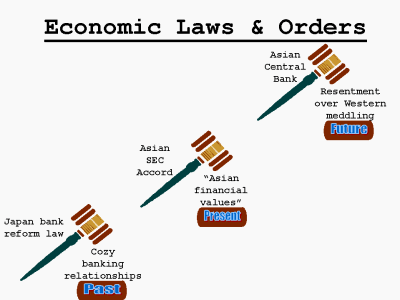
Starting with economics, the Asian order with the longest pedigree is the cozy relationship that exists between major banks and their clients—or borrowers. In the U.S., banks foreclose bad loans based on their own objective economic standards, but in many Asian countries, an unusual degree of closeness exists between bankers and their corporate clients, so much so that a political consensus is often required for the painful decision to actually bankrupt a failing firm. Absent such political decision-making, the tendency of the banks is to let bad debts pile up, creating an untenable overhang for the banking system as a whole. It is exactly this sort of vulnerable situation that convinces foreign investors that currency depreciation is in the offing, which in turn can trigger a currency crisis and/or financial panic. As Japan is one of the worst offenders in this regard, a truly stringent reform of the banking laws there would be viewed as a significant step forward.*
Moving to the near term, we cite the Asian "values" so prominently celebrated during the heyday of the Asian Tigers. In essence, the crux of these "values" is the acceptance of the collusion of corporations, financial markets, and governments in a national economic policy that emphasizes macro-stability and broad-based development via an export strategy and deemphasizes the market’s role in picking winners and losers through competition.** The "new law" proposed here is the creation of an Asian Securities and Exchange Commission.
Looking more to the future, we cite growing Asian resentment over perceived Western meddling, most notably through international financial institutions such as the IMF and World Bank. Both institutions, and the IMF in particular, were harshly criticized for their handling of the Asian Flu.*** The "new law" proposed here is for an Asian Central Bank that would allow the region to—in effect—rescue its own during times of trouble.
* On this subject, see Stephanie Strom, "Japan’s Corporate Woes Compound Bank Troubles," New York Times, 3 April 2001, p. C1; and also "Japan’s Emergency Relief Plan Is Brought Out to a Cool Reception," 6 April 2001, p. B1.
** For an interesting overview of China’s stock markets, see Clay Chandler, "A Bull In China Stocks: Wild Rise Giving Investors Risky Ride," Washington Post, 4 August 2000, p. E1.
*** On this, see John Micklethwait and Adrian Wooldridge, A Future Perfect: The Challenge and Hidden Promise of Globalization (New York: Crown Business, 2000), pp. 174-82.
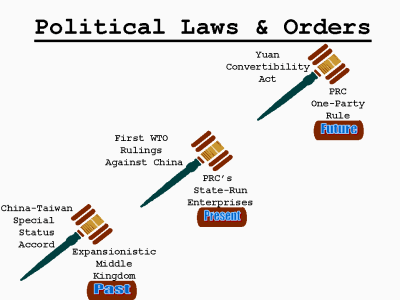
Shifting to politics, we start with the cliché of China as an expansionistic power bent on reconstructing its near-mythical, Middle Kingdom past. We call this a cliché because too many observers tend to extrapolate from China’s efforts to reclaim "lost provinces" a more generalized ambition to gobble up large chunks of Asia. In reality, China’s appetite for expansion has always been narrowly focused.* Now that Macau and Hong Kong are back in the fold, the last significant piece of this puzzle remains China’s claim of sovereignty over Taiwan, which it views as a renegade "province" destined to rejoin the motherland at some point. Because Taiwan represents such a tremendous financial gateway into the Chinese mainland, we note that any accord that would solidify the two countries’ standing with one another—regardless of content— would greatly enhance investor confidence in both.
Looking more to the present, we cite investor concerns over the fate of China’s state-run enterprises, most of whom have long been propped up by subsidies from the state. With China’ imminent accession to the WTO (probably by the end of this year), many of these unprofitable enterprises will face foreign competition for the first time in their existence, leading to many failures within the coming years.** Therefore, how China handles this process will go a long way toward signaling to the outside world its commitment to free markets.
Scanning ahead to the future, we cite Western concerns over the course of one-party rule in China. Clearly, the Chinese Communist Party is weaker now than it has ever been, controlling less and less of the country’s social and economic life as free markets expand across the economy. The real question is, how quietly will the party exit stage left? One step that would quell investors’ fears about that downstream outcome would be for Beijing to make the Yuan, or Renminbi, convertible.*** This development would signal a significant loss party control over the economy, making its inevitable departure from power less uncertain.
* For a counterpoint, see Robert S. Ross, "Beijing as a Conservative Power," Foreign Policy, Mar/April 1997, pp. 33-44.
** For a good overview, see Craig S. Smith, "Chinese See Pain As Well As Profit in New Trade Era: Fears About Job Losses," New York Times, 21 September 20001, p. A1.
***For inklings in this direction, see Craig S. Smith, "China to Let Banks Set Own Interest Rates Over Next 3 Years," New York Times, 20 July 2000, p. C3.
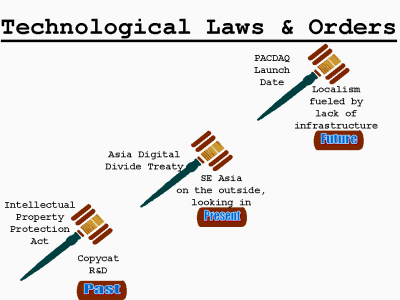
Shifting to technology and looking first to the past, we cite Asia’s long-standing tendency toward copycat R&D, or basically breaking Western patents and copyrights. This issue has long been associated with Japan, and more recently with India’s pharmaceutical industry, where the issue has become caught up in the global debate on how best to handle the AIDS epidemic in Africa.* On another front, one of the U.S.’s main beefs with China over trade has been copyright infringement on recorded entertainment and software, a subject that periodically threatens to poison economic relations between the two. As such, the "new law" proposed would be some sort of treaty or series of national laws outlining Asia’s willingness to enforce the legal concept of intellectual property.
Turning more to the near term, we note the growing concern that Southeast Asia is falling behind in the so-called New Economy, as, relative to the rest of Asia, states here are not attracting the same level of information technology investment. For example, Chinese citizens are twice as likely to use the Internet than Southeast Asians. In short, Southeast Asia lacks much of the physical infrastructure for e-commerce to take root. Plus, the societies there do not adapt well to the transparency required for networks to flourish.** Along these lines, investors would welcome some explicit recognition of this danger by regional governments and coordinated economic incentives to accelerate Southeast Asia’s development of the necessary infrastructure.
Finally, looking more to the future, we note a similar concern. Many of our workshop participants were adamant about dispelling the myth of Asia as one giant undifferentiated market for Western goods and investment. Focusing on localism which they believe is exacerbated by the region’s minimal infrastructure development, one idea proposed was the emergence of an Asian NASDAQ, or PACDAC, that would focus investment toward IT and IT-related infrastructure development.***
* On this point, see Donald G. McNeil, Jr., "Selling Cheap ‘Generic’ Drugs, India’s Copycats Irk Industry," New York TimesI, 1 December 2000, p. A1.
** Wayne Arnold, "Southeast Asia Losing Ground In New Economy, Report Says," New York Times, 7 September 2000, p. C4.
***A Japanese version of the NASDAQ was launched last June. For a brief description, see the report by the Japan Economic Foundation, "Nasdaq Japan market was launched on June 19," .
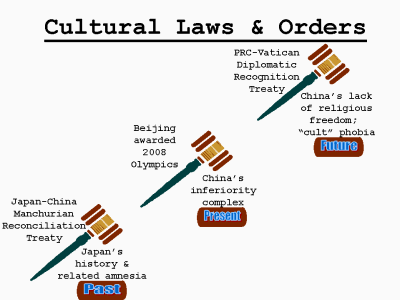
Moving on to culture and focusing first on the past, we note Japan’s continued resistance toward accepting full responsibility for its actions in the Second World War. This historical amnesia perpetuates huge reservoirs of mistrust and even hatred of the Japanese in such countries as South Korea and China, to name the two most prominent cases ("comfort women" and the "rape of Nanking," respectively). To this end, we propose some sort of official reconciliation treaty between China and Japan over the latter’s rule in Manchuria during the 1930s and first half of the 1940s.*
Looking more at the near term, we focus on China’s growing sense of anxiety over its perceived non-acceptance into the ranks of global powers. In short, Beijing wants desperately to be recognized by the world, and the United States in particular, as a relative co-equal, and not merely as an upstart power that needs to be contained. The proposal here is for Beijing to be awarded the 2008 Olympics, signaling its emergence as a world-class city capable of putting on a global show.**
Finally, peering into the more distant future, we note the Chinese leadership’s continuing obsession with cracking down on Falun Gong, out of the fear that cults or religious-based movements have historically played substantial roles in fomenting political upheaval in the country.*** Understanding how these specific fears contribute to an overall hostile religious environment in China, we propose the achievement of a diplomatic recognition treaty between China and the Vatican as a positive step in the direction of demonstrating the government’s willingness to allow greater pluralism in general.
* For a description of one legal case involving Japan’s infamous Unit 731 and its activities in China, see Howard W. French, "Japanese Veteran Testifies in War Atrocity Lawsuit," New York Times, 21 December 2000, p. A3; see also Doug Struck, "Chinese Confront Japan In Court: Germ Warfare Victims Testify," Washington Post, 9 March 2001, p. A20.
** Another interesting idea along this line (but probably a lot farther off) would be the awarding of an National Basketball Association franchise. The first ever Chinese player joined the Dallas Mavericks this season.
*** For an overview on the resurgence of religion in China, see John Pomfret, "Old-Time Religion Popular Again in Rural China," Washington Post, 24 August 1998, p. A1.
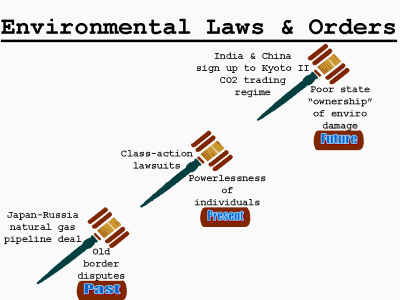
Shifting over to the environment and focusing more on the past, we cite the plethora of border and maritime disputes between major powers in the region, with a number of countries still technically at war with one another (dating back to WWII). Paraphrasing Robert Frost, we believe good pipelines make good neighbors, and given the region’s skyrocketing requirements for oil and natural gas, it only seems natural that these old border disputes should be put aside in favor of linking energy producers and consumers. A good example of a breakthrough in this arena would be Japan and Russia moving past the Kurile Islands dispute and finally going ahead with one of the natural gas pipelines currently proposed.*
Looking more at the near term, we highlight the general powerlessness of individuals to seek redress for personal and property damage brought about by environmental pollution. One way to achieve some corporate responsibility in this arena would be class-action lawsuits that would begin to define the private-sector’s responsibility for the environment.**
Looking ahead to the future, we note the failure of any advanced economy to ratify the Kyoto Protocol on climate control, in large part because of resentment over the fact that large, emerging economies such as China and India were excluded from the regulatory regime. To that end, we propose the notion of a successor Kyoto accord that would be far more inclusive and thus present a better chance for a global consensus to emerge.
* On this subject, see Mark J. Valencia, "Energy and Insecurity in Asia," Survival, Autumn 1997, pp. 85-106.
** For a good example of this sort of progress, see Elisabeth Rosenthal, "Pollution Victims Start to Fight Back in China," New York Times, 16 May 2000, p. A1.
*** For some of the arguments against the Kyoto Protocol and the rationale behind President George W. Bush’s recent decision to turn the U.S. away from that agreement, see Andrew C. Revkin, "Bush’s Shift Could Doom Air Pact, Some Say," New York Times, 17 March 2001, p. A7.
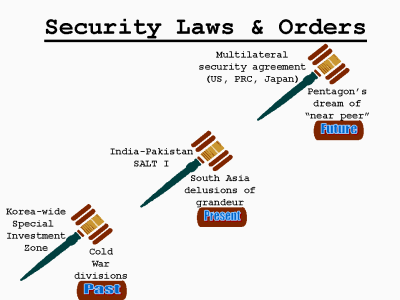
Finishing up with security, we first zero in on the region’s most prominent Cold War hangover: the divided Korean peninsula. The consensus we heard at the workshop—especially from the Wall Street participants—was that South Korea should not wait until North Korea collapses to begin trying to "buy out" the regime in every sector possible. In other words, rather than wait out Pyongyang and face a very expensive reunification process, Seoul is better off seeking economic integration now, even at the risk of lengthening the socialist government’s life span. Exposure to South Korea’s vastly higher standard of living can only have a subversive effect on the North Korean regime’s legitimacy. Meanwhile, the deeper Seoul’s financial tentacles reach into the North Korean economy, the easier the process of later reunification.
Looking more at current events, we highlight the dangerous nuclear standoff between India and Pakistan, where the focus of conflict is the disputed Indian state of Jammu and Kashmir. Radm K. Raja Menon, Indian Navy (ret.) likes to say that India’s national security paradigm remains trapped within "the sacred soil syndrome."* On the one hand, you could argue that no nation has lost more land since WWII (e.g., Pakistan, Bangladesh). On the other hand, no economy today better demonstrates the "death of distance" associated with information technology. As Thomas Friedman might say, India is at once a leading "Lexus" economy (i.e., high-technology producer) and a classic "olive tree" society (i..e., still fighting over seemingly meaningless bits of land). To move India beyond this trap, we look to some strategic arms limitation treaty with Pakistan.**
Looking ahead to the future, we target the Pentagon’s never-ending search for a "near peer," which is clearly focused on China. Granted that Wall Street has a different appreciation for China, they would welcome some downstream multilateral security agreement that brought together the U.S., China, and Japan.
* This quote comes from RAdm. Menon’s presentation to the International Maritime Seminar held in conjunction with the Indian Navy’s first-ever International Fleet Review in Mumbai, India, 16 February 2001.
** For an overview of Indian national security strategy, see Thomas P.M. Barnett, "India’s 12 Steps to a World-Class Navy," Proceedings, forthcoming.
VII: The There and Then of FDI in Asia

Moving into the third and last of our "diamond dialectics," we now turn to the subject of Tipping Points, a concept we borrow from Malcolm Gladwell’s recent book by the same name.*
In a nutshell, we’re employing the term tipping point to mean a pinnacle moment in the adoption of a new understanding or perception (i.e., a paradigm shift), beyond which we can speak about a "new rule set" becoming thoroughly embedded in a country’s (or region’s) political and economic culture.
To illustrate this point, we employ the imagery of Sisyphus (see following slides), the legendary king of Corinth who was condemned, according to Greek myth, to roll a heavy rock up a hill in Hades only to have it roll down again as it nears the top—ad infinitum. While not wanting to insinuate that these tipping points are, by any stretch of the imagination, unachievable, we do want to impress upon the reader our sense that these "journeys" will not be easy ones.
We will propose six tipping points, corresponding—yet again—to our six global lenses (economics, politics, technology, culture, environment, security).
* Malcolm Gladwell, The Tipping Point: How Little Things Can Make a Big Difference (New York: Little Brown & Co., 2000).
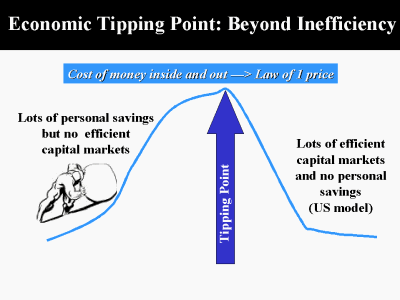
In this first tipping point, we focus in on the key economic paradigm shift that needs to occur to improve the long term climate for FDI in Developing Asia. In a nutshell, it is fair to say that the current investment environment in Asia is almost the complete opposite of that in the United States. In the U.S., most individuals have little to no personal savings (i.e., traditional bank accounts), but do have financial assets at work in various capital markets, such as stocks and bonds. In Asia, the situation is completely reversed: many individuals have substantial personal savings in traditional banking institutions, but few of their financial assets find useful employment in capital markets.
The tipping point is obviously the development of efficient capital markets that are universally accessed. At that point, the cost of money both inside and out are equalized, meaning that—all things being equal—individuals and firms should not care about where their capital comes from because all available capital adheres to the "law of one price." When Developing Asia’s capital markets reach this tipping point, the economies there become indifferent about Western versus Asian sources of FDI, giving them maximum choice opportunities and fostering competitive rates for all.
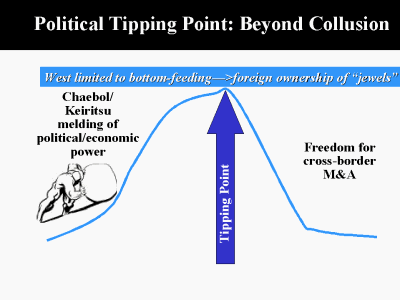
In this second tipping point, we focus in on the desired political paradigm shift. Here we highlight the issue of ownership within the economy. In the classic Asian format, exemplified by the chaebol (South Korea’s industrial conglomerates) and the keiritsu (Japan’s families of companies), complex patterns of cross-ownership and financial alliances lead to a melding of political and economic power in a system best described by the oxymoron "state-directed capitalism." The extreme closeness between public and private sectors allows for focused national economic policy, but likewise facilitates protectionist tendencies, seen most vividly in the inability of foreign investors to achieve significant levels of direct ownership in these economies.
For now, the West is largely limited to bottom feeding (buying only the most distressed firms) in the more closed Asian economies. A tipping point would therefore come when foreign firms are freely able to merge and/or acquire (M&A) not just the "losers," but the real "jewels" (meaning high-profile firms or assets, like famous chunks of real estate or signature companies in media, entertainment, energy, or finance). We know Asia reaches a tipping point when we are able to buy outright the Asian equivalents of the Chrysler Building, MGM Studios, the Los Angeles Dodgers, Pacific Gas & Electric, or J.P. Morgan.
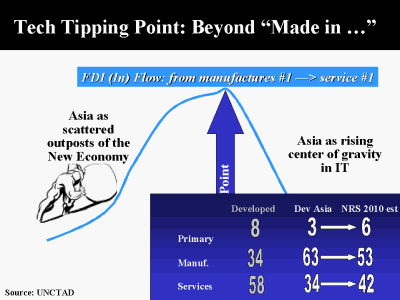
In this third tipping point, we focus in on the desired technological paradigm shift. Here we zero in on the issue of which sector of the economy receives the most FDI attention. Right now, Asia is a collection of scattered outposts of the New Economy, or—better said—increasingly networked enclaves, but enclaves nonetheless. In other words, many Developing Asian states have a hard time integrating high technology throughout their economies as a whole, even as—collectively—Asia continues to rise as a new global center of gravity in IT (both in terms of hardware and software).*
The measure we chose to focus on here is sector shares of inward FDI flows. In developed economies, almost 60 percent of inward FDI flows go to the service sector, with just over 40 percent going to the primary and manufacturing sectors combined. In contrast, Developing Asia’s current inward flows display the opposite spread: two-thirds to primary and manufacturing and one-third to services. A tipping point that suggests Developing Asia has achieved more broadly based integration of information technology will be when FDI flows into the service sector outpace that of the manufacturing sector.
Along these lines, we asked our participants to vote on what they think the likely sector shares will be for Developing Asia in 2010. The results displayed above suggest that considerable ground can be covered within the next decade and that this tipping point is likely to be achieved within a generation.
* On this, see Celia W. Dugger, "In India, Unwired Villages Mired in Distant Past," New York Times, 19 March 2000, p. A1.
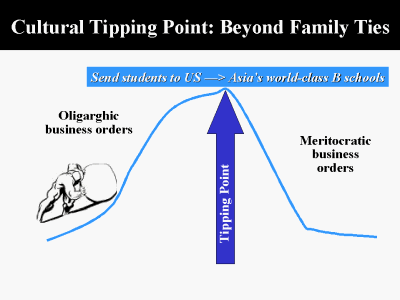
In this fourth tipping point, we focus in on the desired cultural paradigm shift. Here we emphasize the shift from the region’s current oligarghic business culture to one more clearly based on merit. The key ingredient to a meritocracy, however, is universal access to education, and here Asia lags desperately behind the rest of the world. But more pertinently, the entire region currently lacks a graduate business school with an international reputation of a Harvard, Wharton, or University of Chicago. Instead, Asia (mostly its elite) has taken to sending large number of students to U.S. universities, where too many are lost for good to the West.
So we choose as a tipping point the development of world-class business schools in Asia, be they of Asian origin or Western export. Hopeful signs in this regard include:
- Prominent U.S. and European business schools establishing satellite operations throughout Asia*
- A decline in the brain drain to the West for both India and China, as young people start to return in numbers following the achievement of degrees or simply stay behind as career opportunities improve.**
* See David Leonhardt, "All the World’s a Campus: Top Business Schools Have No Borders," New York Times, 20 September 2000, p. C1.
** See Pamela Constable, "India’s Brain Drain Eases Off: For Best and Brightest, Staying Home Is Option to High- Tech Jobs in U.S.," Washington Post, 14 September 2000, p. A23; and John Pomfret, "A Brain Gain for China: Western-Trained Professionals Return," Washington Post, 16 October 2000, p. A1.
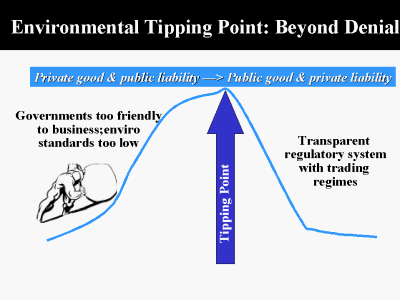
In this fifth tipping point, we focus in on the desired environmental paradigm shift. Here we explore the reality that most governments simply have not yet stepped up to the plate on environmentalism, remaining too friendly with the private sector and barely enforcing standards that are far too lax. According to Daniel C. Esty, an expert on international environmental standards at Yale University, "The worst pollution in the world is unequivocally in Asia. The statistics on China are stunning, and right behind those Chinese cities stand almost every other major city of Asia." The World Health Organization estimates that roughly 2 million people die each year from air and water pollution. Which means, as New York Times reporter Nicholas Kristof notes, that more Asians die each year of pollution than perished in the entire Vietnam conflict across the 1950s, 1960s, and 1970s.*
Asia’s historical tendency has been to treat the environment as a private good with limited public liability. What they need is a mindset that says the environment is a public good worth protecting, with private liability for those who pollute or otherwise damage it. But because the region’s development needs are so great, we believe the best route to a green future is one built on transparent capping systems employing trading regimes that allow the most responsive firms to monetize their efficiencies and the least responsive ones to purchase credits.
* The quote and World Health Organization data are cited in Nicholas D. Kristof, "The Filthy Earth," in Kristof and WuDunn, Thunder From the East, p. 295.
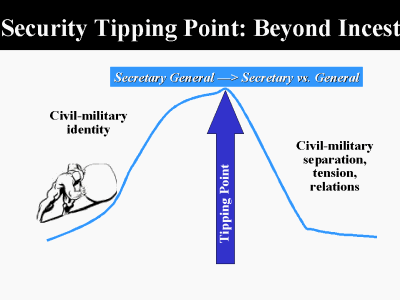
In this last tipping point, we focus in on the desired security paradigm shift.* Here we target the lack of genuine civil-military relations in many Asian states. What we mean by that is, in too many instances, there is civil-military identity rather than true separation and natural tension. The classic example is the military leader who also holds tremendous political power within the government, and then also controls significant private-sector assets. This situation is bad on four levels:
- It gives the military too much influence within governments
- It offers the military too much protection from both market and political forces that might otherwise stem defense spending
- It detracts from the professionalism of the military, as we have seen in China in recent years when the military was encouraged to "self-finance"
- It presents the military with too many opportunities to crowd out natural market growth due to their relatively large weight in the national economy.
When Asian generals and admirals are limited to only one title, then we will know that a tipping point has been reached—namely, the role of the military has been appropriately subsumed to a background, enabling function with regard to overall FDI climate.
* Thanks to David Harries in particular for this concept.

Shifting from Tipping Points to the There and Then, we’ll now examine a quartet of rudimentary outcome scenarios for Asia’s potential investment future. We call them "rudimentary" because we won’t present any great detail as to the alternative futures they portend. Rather, we’ll offer them up as a way to capture varying degrees of optimism/concern exhibited by workshop participants regarding the likelihood of each pathway’s unfolding.
The scenarios were framed in the following fashion:
- We constructed the X-Y axis beforehand and presented it "ready-made" to workshop participants at the beginning of the "Outcome Scenarios" session.
- The participants then spent several minutes brainstorming—via GroupSystems—notional "headlines from the future" that served as illustrations for each of the four scenarios; selections of these headlines are presented in the next section.
- Following facilitated group discussion of the four scenarios, participants nominated—via GroupSystems—titles for each of the four scenarios.
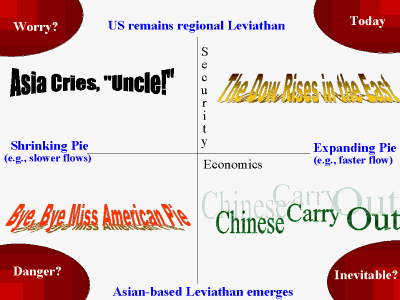
The X-Y axis is constructed of two simple questions:
- What is the nature of the regional security environment?
- Does the U.S. remain the regional Leviathan?
- Or does an Asian-based Leviathan emerge (either singular or collective)?
- What is the relative flow of FDI into the region?
- Does the "pie" continue to grow?
- Or does a Western economic crisis reduce it significantly?
The four resulting scenario titles are as follows:
- The Dow Rises in the East (U.S. as Levithan + Expanding Pie) reflected the optimisim of those who see Asia as still a largely untapped market for both trade and investment. In this scenario, an expanding pie keeps Asia’s great powers more focused on economic development than arms races, enabling the U.S. to retain its Leviathan status. This scenario was seen as a simple extrapolation from today.
- Asia Cries, "Uncle!" (U.S. as Leviathan + Shrinking Pie) reflected the concern of many participants that an economic slowdown in the West would not only shrink the cross- regional FDI flow, but likewise put the U.S. in the awkward position of trying to enable security in a region undergoing increasing economic and political stress—think of an "Asian Pneumonia" next time around. The worry here was that the U.S. would have a hard time avoiding the perception of being a bully/taskmaster, not just in security affairs but also in economic relations—especially as the IMF and World Bank are perceived to do our bidding.
- Bye, Bye Miss American Pie (Asian Leviathan + Shrinking Pie) reflected the opinion of most participants that, in the event of a severe economic downturn in the West, U.S. military presence in Asia could well come under pressure back home. If U.S. financial and security presence were simultaneously curtailed, Asia’s adherence to the concept of a single global economic rule set would surely decay. The danger seen in this scenario is one of Asia pursuing a competitive rule set, or one that rejects not only Western dominance in security matters, but financial ones as well.
- Chinese Carry Out (Asian Leviathan + Expanding Pie) reflected the sense of inevitability that some participants felt about a security challenge eventually rising in Asia due to China’s rapid rise in the global economy. Simply put, an economy that grows that much cannot adopt the security posture of some small trading state. But security challenge to whom exactly? Japan? India? The United States? Everyone? And what strategy does an emerging China seek to carry out once it has "arrived"?

In this section, we flesh out our long-term scenarios a bit by providing several "headlines from the future" for each quadrant. These headlines were generated by the workshop participants as a way of populating the outcome scenarios. Of the several hundred notional headlines provided, we selected two dozen that we felt captured the lion’s share of our participants’ concerns and/or desires regarding Asia’s future investment paths.
As for which headlines constitute Good News or Bad News, we leave that judgment to the reader.
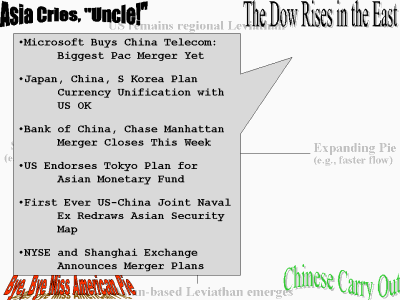
First we examine the scenario that most closely resembles an extrapolation from today’s situation: The Dow Rises in the East.
Four themes emerged among the numerous entries we received for this scenario whereby the U.S. remains regional Leviathan and the FDI pie continues to expand:
- A growing military cooperation between the U.S. and China
- A rapid acceleration of mergers and acquisitions in both directions, to include real "jewels"
- An integration of financial markets
- Economic integration within Asia that did not trigger U.S. fears of being shut out.
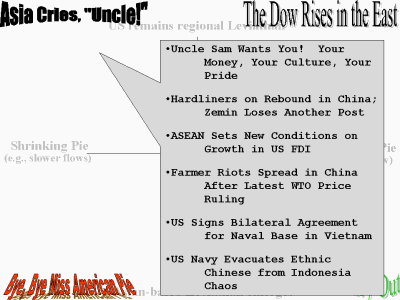
Next we examine the scenario entitled Asia Cries, "Uncle!"
Four themes emerged among the many entries we received for this scenario, whereby the U.S. remains regional Leviathan but the FDI pie shrinks significantly:
- China, failing in the heightened global economic competition, turning rightward and inward
- Increased xenophobia and social anxiety about globalization
- A search for domestic scapegoats as well
- The U.S. perceived as pursuing a security posture in the region akin to a colonial power.
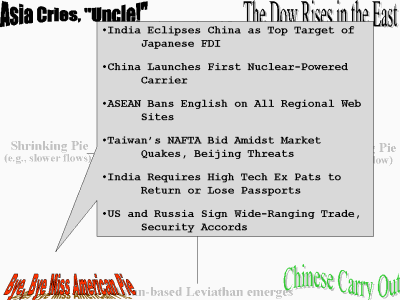
Here we examine the scenario entitled Bye Bye Miss American Pie.
Four themes emerged among the many entries we received for this scenario, whereby an Asian Leviathan emerges under the conditions of a shrinking FDI pie:
- Within the region, major states begin allying themselves against China
- Increased xenophobia leading to active anti-Westernization measures
- Some smaller states seeking U.S. "adoption" due to heightened security fears
- Russia and the U.S. finding new reasons for cooperation
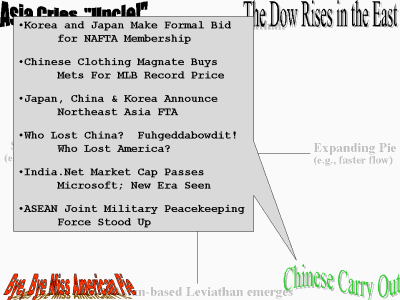
Finally we examine the scenario entitled Chinese Carry Out.
Four themes emerged among the many entries we received for this scenario, whereby an Asian Leviathan emerges under the conditions of an expanding FDI pie:
- The most Western states seek explicit economic union with the United States
- China replaces Japan as the Asian economy we most respect and fear
- India’s emergence as an IT superpower provides some balance to China’s emergence as a manufacturing superpower
- China becomes the "France" of Asian security: always pushing for regional solutions that limit the role of the U.S., while being careful never to engage us head-on.

We wrap up our presentation of workshop output with an exploration of the concept of "connectivity," as suggested by the Internet-based trivial pursuit known as the Kevin Bacon Game (or alternately, Six Degrees of Kevin Bacon). This popular movie trivia game is based on the notion of trying to determine the shortest number of linked steps between any two points.*
After explaining how the game works and what it suggests about connectivity, we’ll show you how we used it in our workshop to get our participants to think about the "most connected" FDI targets in Developing Asia.
* The discussion of the Kevin Bacon Game that follows is based on Malcolm Gladwell’s description of the same in his chapter, "The Law of the Few: Connectors, Mavens, and Salesmen," pp. 46-49, The Tipping Point.

According to the Oracle of Bacon, the most comprehensive version of the Kevin Bacon Game on the Internet, "The object of the game is to start with any actor or actress who has been in a movie and connect them to Kevin Bacon in the smallest number of links possible."* Two actors are linked if they've been in a movie together, but links through television shows, made-for-TV movies, or through production staff (e.g., writers, producers, directors) do not count. Most actors can be linked in 4 steps or less, meaning a typical "Bacon number" for any actor is 2 or 3, meaning it takes 2 or 3 movies to link the subject in question to Kevin Bacon.
According to the University of Virginia’s School of Engineering and Applied Science (Department of Computer Science), which maintains the Oracle of Bacon web site, the average Bacon number for all actors is roughly 2.8, based on a combined pool of approximately 450,000 actors.**
The example we use here is Kevin Kline, who can be linked to Kevin Bacon in as few as 2 steps, but we use 3 movies here, to make it a little easier.
Spend a minute to contemplate which two actors appearing across three movies will link Kevin Kline to Kevin Bacon. The process would go something like this:
- Kevin Kline + Actor A in Movie #1
- Actor A + Actor B in Movie #2
- Actor B + Kevin Bacon in Movie #3.
Then check out our preferred answer on the next slide.
* The Oracle of Bacon is found at <http://www.cs.virginia.edu/oracle>. The Oracle uses data from the Internet Movie Database <http://us.imdb.com>.
** Cited at <http://www.cs.virginia.edu/cgi-bin/oracle/center-cgi?who=Kevin+Bacon>.

Here’s how we do it:
- Kevin Kline appears with Meg Ryan in French Kiss (1995), a romantic comedy. That’s movie link #1.
- Meg Ryan appears with Tom Hanks in Sleepless in Seattle (1993), another romantic comedy. That’s movie link #2.
- Tom Hanks appears with Kevin Bacon in Apollo 13 (1995), a space adventure based on a true story. That’s movie link #3.
So Kevin Kline is easily linked to Kevin Bacon in three steps.*
Of course, so long as movies are being made, any actor’s Kevin Bacon number can rise or fall, depending on who appears in movies with them (especially if that person is Kevin Bacon).
Who is the actor who currently holds the lowest Kevin Bacon number at 2.599102? Turn the page and find out.
* According to the Oracle of Bacon, Kevin Kline actually has a Bacon Number of 2 (he appears with Diane Lane in Chaplin (1992) and she appears with Kevin Bacon in My Dog Skip (2000). When Kevin Kline finally acts in a movie with Kevin Bacon, he will join the exalted ranks of actor who possess a Kevin Bacon number of one (approximately 1,500 actors currently enjoy this recognition), according to the Oracle site. The only actor with a Kevin Bacon number of zero is—of course —Kevin Bacon himself.

The current holder of the lowest Kevin Bacon number is Christopher Lee, who recently edged out the long-time reigning champion, Rod Steiger.
What makes Christopher Lee the most connected actor of all time?
- He has been acting for a long time, appearing in his first movie, Corridors of Mirrors, in 1948.
- He has acted in a lot of movies, 215 in all (including the next Star Wars movie due in theaters in 2002).
- He is a "character actor," meaning not the lead actor, in the vast majority of his movies.
- He has appeared in all sorts of movies.
These characteristics are what make him the most connected Hollywood movie actor of all time. Does this make him the most powerful or most famous movie actor of all time? Obviously not, but it does mean that—compared to actors in general—he is extremely well-known within the industry. In short, if you wanted "inside information" on the widest array of industry players over time, he would be your best source among actors—your quickest link.
What makes for a well-connected player in direct investment flows to a particular region?
- That country would have a long-established reputation as both a target and source of investment flows. It would be considered a gateway to other economies.
- It would be a high-volume player. When measured as a percent of GDP, its inward and outward stock would register a relatively high percentage, meaning more than 50 percent.
- It is more than likely not a huge industrial state, but rather a smaller, trading state with strong financial markets.
- It would deal in a broad array of sector investments, demonstrating great versatility in its partnerships both within the region and throughout the world.
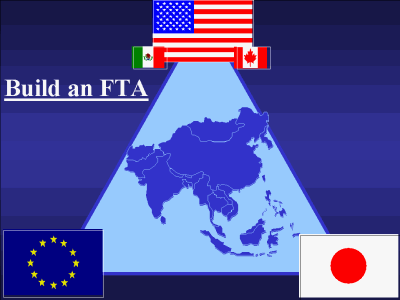
Our version of the Kevin Bacon Game was to ask our participants to construct a variety of Free Trade Areas linking Developing Asia to the three main sources of global FDI—the Triad members.*
Here is how we did it:
- We presented the participants with a list of states in Developing Asia (note that we did not break Hong Kong out as a separate player).
- Then we asked them to construct a Free Trade Area from the direction of NAFTA. Specifically, we asked them to choose the ten "best" countries for a NAFTA-led Free Trade Area that linked North America with Developing Asia.
- Then we did the same for both the European Union and Japan.
- Finally, we combined the top-ten rankings from all three Free Trade Areas to determine those Developing Asian economies with the lowest Kevin Bacon-like number, meaning the countries most easily connected to other countries in the region though FDI flows, as estimated by our diverse group of participants.
In each vote, we instructed the participants to consider:
- All the characteristics of a well-connected state
- Which states would provide the best fit with the primary FDI source in question, not just in terms of economic compatibility (and certainly not just the absolute size of the economy), but also political, technological, cultural, environmental and security "fits."
* For some examples of countries currently moving in this direction, see Agence France-Presse, "China Outlines Need For Free-Trade Zone," New York Times, 26 November 2000, p. NE9; Joseph Kahn, "Practicing What Free Traders Preach," New York Times, 3 December 2000, p. WK6; and Elizabeth Olson, "Regional Trade Pacts Thrive As the Big Players Fail to Act," New York Times, 28 December 2000, p. W1.
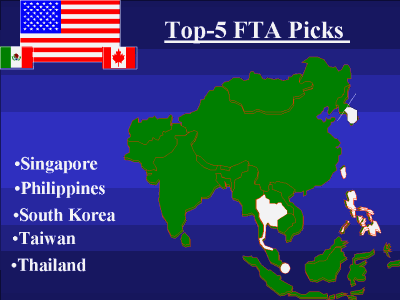
Our first vote on a NAFTA-led Free Trade Area for Developing Asia yielded the following top-5 candidates:
- Singapore: former British colony, like the U.S. and Canada; following loss of U.S. military base in Philippines, security relationship with U.S. blossoms rapidly
- Philippines: former "possession" of the U.S.; until recently, long-time site of U.S. military facilities; member of U.S.-dominated South East Asia Treaty Organization (SEATO) during Cold War
- South Korea: strong security alliance with U.S.
- Taiwan: strong security relationship with U.S.
- Thailand: good military ally of the U.S. in the region; member of SEATO.
Note that none of these states has had anything close to an adversarial security relationship with the U.S. since the Second World War.
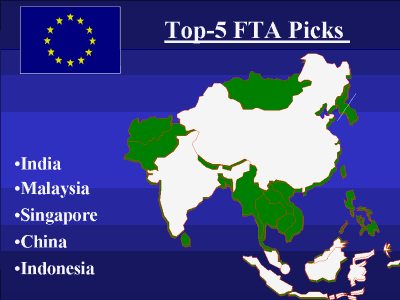
Our second vote on an EU-led Free Trade Area for Developing Asia yielded the following top-5 candidates:
- India: past colonial ties to Portugal, France and UK
- Malaysia: past colonial ties to Portugal, Netherlands, and UK
- Singapore: former British colony
- China: past colonial ties to several European powers over the centuries
- Indonesia: past colonial ties to Portugal, Netherlands, and UK.
Note that—at one time or another—all five states were colonized in some portion by European powers. It must have been that sort of colonial hubris that pushed our participants to envision a FTA that includes both India and China. Then again, China just joined the so-called Bangkok Agreement that reduces tariffs on over 600 products among the following countries: India, South Korea, Laos, Sri Lanka and Bangladesh.*
*The Bangkok Agreement was formulated in 1975.
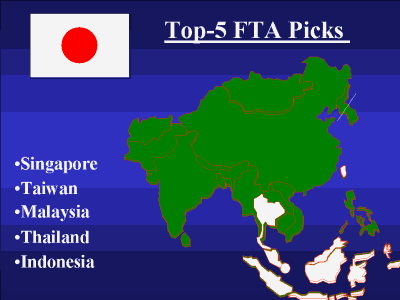
Our third vote on a Japan-led Free Trade Area for Developing Asia yielded the following top-5 candidates:
- Singapore:occupied by Japan during WWII
- Taiwan: former Japanese colony
- Malaysia: occupied by Japan during WWII
- Thailand: occupied by Japan during WWII; later Japan’s ally during the conflict
- Indonesia: occupied by Japan during WWII.
Note—yet again—the linkages between past security-based relationships and current financial relationships.
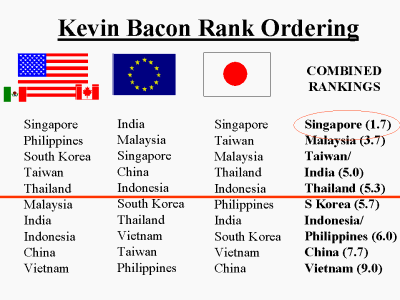
In this slide we present the top-ten lists for all three Free Trade Areas constructed by our participants. Note first how they all selected the same ten states, just not in the same order. The line across the middle separates the top five from the bottom five. Combined rankings (an average of the three ranks) appear on the far right.
Based on this process, we declare Singapore to have the lowest Kevin Bacon-like score on FDI connectivity. This should not be surprising. Singapore has the second largest inward and outward FDI stock totals in Developing Asia (after China/Hong Kong). The global average for FDI as a percentage of GDP is approximately 14, both inward and outward. Singapore’s outward stock percentage is 56, while its inward share is 86 percent.
Singapore has had strong past/current political-military relationships with all three global pillars of FDI. It is a well-known and much trusted player. It is the closest thing in Asia to a pure trading state (now that Hong Kong has joined China).
In sum, it was the collective judgment of our participants that, if you wanted your investments in Developing Asia to have the greatest flexibility and reach—or the most connectivity—Singapore was the best place to start. For once your money enters Singapore, it can move elsewhere around the region in the fewest number of steps.
Not surprisingly, a recent Economist survey cited Singapore as having the highest ratings for quality of corporate governance, transparency, and rule of law —all characteristics you would expect from the Kevin Bacon of Asian FDI flows.*
* See Kluth, "A Survey of Asian Business," pp. 4 & 16. The source of the survey data is Political and Economic Risk Consultancy.
VIII: Cosmic Conclusions About the Future(s) of FDI in Asia

Having worked our way through our conceptual model and presented the output from the Foreign Direct Investment event, we’d now like to wrap up this report with a handful of "cosmic conclusions" about the future(s) of Asian economic development.

One thing we heard several times throughout the workshop and in subsequent email traffic was how so many of our participants were excited about long term investment prospects in India, primarily in information technology but also in pharmaceuticals and energy.
India is hard for Westerners to grasp due to its enormous and eclectic population. If you took the population of the entire Western hemisphere and crammed it into the U.S. west of the Mississippi, you would have something like an India. There would be plenty of very rich people, about three hundred million middle class, a similarly sized working poor, and then even more people living in abject poverty—all in the same country. And then there is the incredible diversity: the religions, the languages, the lingering caste divisions.*
But as we stated earlier, India is a very important country for the future of globalization.** With everything it offers the New Economy, the world needs India to be a success story. But for that story to be written, India needs substantial foreign investment.
To date India has attracted about as much FDI inward stock ($16 billion through 1999) as long-isolated Vietnam ($15 billion), with roughly half of that coming in a three-year spurt between 1995 to 1998, peaking in 1997 at a flow of 3.5 billion but declining since then.***
What struck us about the workshop was the enthusiastic sense of many participants that India was turning a corner in terms of global perceptions of its investment climate. In some ways, the manner in which participants spoke about India’s prospects reminded us of how people spoke about China’s prospects half a decade earlier. Can India make such a leap into "star"economy status? Much depends on how its IT sector holds up during the current slowdown in the West.
* On India as a nation, see Shashi Tharoor, India: From Midnight to the Millennium (New York: Harper Perennial, 1998).
**On how globalization is changing the lives of average citizens in India, see James Traub, "Keeping Up With the Shidhayes: India’s New Middle Class, New York Times Magazine, 15 April, p. 20.
***Data comes from UNCTAD, World Investment Review 2000, p. 297.

One statement we heard time and time again during the workshop was, "If we were having this workshop back in 1990 instead of 2000, imagine how much we would have been talking about a Japan dominating Asia versus a China." Indeed, thinking back to the national debates triggered by Paul Kennedy’s 1989 book, The Rise and Fall of the Great Powers, you would half-expected that the subject of our workshop might have been Japan’s dominant FDI position in the United States and what we were going to do to protect ourselves.
The point the participants were trying to make was two-fold. First, it certainly is hard to predict the economic future of great powers.
But more importantly, it would be just as irresponsible now to count Japan out as a future crucial player in Developing Asia because of its prolonged economic slump and financial crisis. Japan has displayed an uncanny knack for painful rebirth and resurrection over the course of its history. Recent calls by some senior officials to let the economy "die once so that it can live again" suggest that the country is moving ever closer to the drastic steps many financial experts have long advocated for a banking sector awash in bad loans.*
How Japan emerges from this crisis will go a long way toward determining the future course of investment and economic development across Asia as a whole. Japan is simply too big a piece of Asia’s FDI puzzle to be discarded, no matter how dire its short term situation becomes.
* On this notion, see Clay Chandler, "As Japan’s Economy Sags, Many Favor a Collapse," Washington Post, 9 March 2001, p. A1.
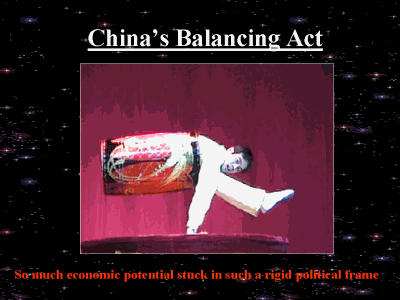
It has been said so many times about China, but we will say it again here: something has got to give over the coming years. Either the politics will come unglued from the social pressures created by all this economic development or, if political leaders cling too tightly to their controlling ways, the economy will eventually fall victim to one of the several "train wrecks" predicted (e.g., banking crisis, regional disparities growing too large, massive unemployment due to foreign competition).
In terms of FDI, China remains one of the world’s most intriguing products, trapped within one of the world’s worst packages. Deng Xiaoping decided to reform economics before politics, and since Mikhail Gorbachev proved just how hard the opposite course was for the former Soviet Union, it is hard to argue with his strategic choice. But China will be dealing with those political reforms over the coming decade, whether it wants to or not.
In short, what the Second Generation of leaders (Deng) started in economics has not been matched by the Third Generation (Jiang Zemin, Zhu Rongji) in the political realm, largely in frightened response to the Tianamen Square protests of 1989. Now as the so-called Fourth Generation rises to power in the next two to three years, questions abound about their willingness to further political reform in response to economic advance.
This Fourth Generation, however, is rightly described as the stay-at-home generation. They did not travel to Russia for education like the Third Generation, nor do they resemble the Fifth Generation that spent so many formative years in the U.S. and Europe.* One thing is clear: this cohort is relatively non-ideological and technocratic in outlook. Oddly enough, a few prescient Soviet watchers were quietly pointing out the same things about the Gorbachev generation just as they came on the national stage in the mid 1980s.
* On the Fourth Generation, see John Pomfret, "China’s Generational Shift: People’s Congress May Signal Rise Of New Leaders," Washington Post, 5 March 2001, p. A12.

Much has been made about Developing Asia’s tremendous future requirements for foreign investment, especially in infrastructure development and energy. Given the huge sums projected, many have made the case—including us—that Asia has no choice but to turn to the West for a good portion of that investment flow.
While not backing away from previous statements, we do feel the need to point out the tremendous sums of personal savings in Asia that remain largely untapped in this development process, primarily because the region lacks efficient capital markets that are broadly accessible to the bulk of the population. Looking at just China and Japan, we have come across numerous estimates that suggest if Asians had the same access to capital markets as most Americans do, Developing Asia’s opportunities for intra-Asian FDI might be significantly enhanced.*
For now, these assets remain largely trapped in unproductive savings accounts and pension funds. They remain a variable of considerable potential importance, but one dependent upon new rule sets emerging in Asia to free them for better employment.
* Good references include the Japan Statistical Yearbook, Standard & Poor’s Current Statistics, and various annual reports by the International Monetary Fund (World Economic Outlook), the Organization for Economic Cooperation and Development (International Direct Investment Statistics Yearbook), and the United Nations (Statistical Yearbook).
Our fifth and final cosmic conclusion is, in many ways, a larger argument (and advertisement) for the NewRuleSets.Project as a whole. It is the same argument upon which we ended our first report on Asian Energy Futures.
After each of the Economic Security Exercises we’ve conducted over the past five years, participants walk away from the experience speaking excitedly about a new sense of understanding of the connectivity between the security and economic worlds—namely, how the two work in tandem to provide international stability.
We like to describe this combination effect as the global rule set, or what we’ve come to understand as the ultimate international peace dividend arising from the end of the Cold War. As stated earlier, the collapse of the Soviet Bloc and its long-standing challenge (or rejection) of the Western economic rule set made possible—really for the first time in human history—a truly worldwide rule set for how military power buttresses and enables economic growth and stability.
How so? For the first time in human history we have a true global military Leviathan in the form of the U.S. military, and no peer competitor in sight—not even a coherent alternative economic philosophy (although one clearly brews in the anti-globalization protests of Seattle Man). This unparalleled moment in history both allows and compels the United States to better understand the security-economic nexus, in large part because of its complete reversal of priority from the Cold War. During the strategic stand-off with the Soviet Union, economic might was seen as supporting military power, but now that situation is completely reversed: to the extent that the military matters, it matters because it stabilizes the global economy.
How do we define this ying-and-yang relationship between the military and economic worlds?
First we speak of stability, which comes from military security, and then we speak of transparency, which is both demanded by, and engendered by, free markets. These two underlying pillars form the basis of the single global rule set that now essentially defines the Era of Globalization.
Within those two pillars, the U.S. clearly plays a crucial role:
- The U.S. Government, through the U.S. military, supplies the lion’s share of system stability through its Leviathan-like status as the world’s sole military superpower.
- The U.S. financial markets, which lead the way in fostering the emergence of a truly global equities market that will inevitably operate 24-7-365, play the leading role in spreading the gospel of transparency, in large part because it’s any country’s best defense against the sort of financial currency crises that have periodically erupted over the last decade (Mexico 1994, Asia 1997, Russia 1998, Brazil 1999, Turkey and Argentina 2001).
As such, it is essential that these two worlds—military and financial—come to better understand their interrelationships across the global economy.
Uncovering and better understanding this fundamental relationship is especially important because—the vast majority of the time—the military and business communities operate in oblivious indifference to one another.
One’s tempted to counter, "So what? They don’t need to be aware of one another on a day-to-day basis."
And in a basic sense, that’s true. But if you consider the rise of system perturbations as a new form of international security threat in the 1990s, and if you understand that most of these perturbations come in the form of financial crises that can engender serious subnational violence (e.g., Indonesia today), then perhaps this connectivity seems more pertinent. Because ultimately the global economy operates on trust, which is based on certainty, which in turn comes from the effective processing of risk.
In the end, the military and financial markets are in the same business: the effective processing of risk. For the military, it’s the risk of conflict and the disruption of normal life by large-scale violence, while in the financial world, it’s the risk of bankruptcy (insolvency) and the disruption of normal business by large-scale panics or failures.
Invariably, these two problem sets merge in the increasingly interdependent, IT-driven, globalizing New Economy, so understanding the military-economic connection isn’t just good business, it’s good national security.